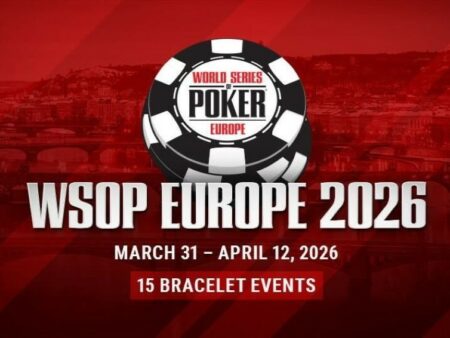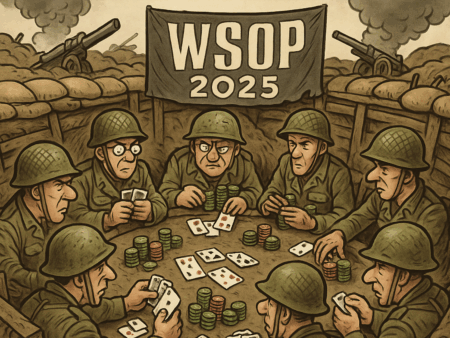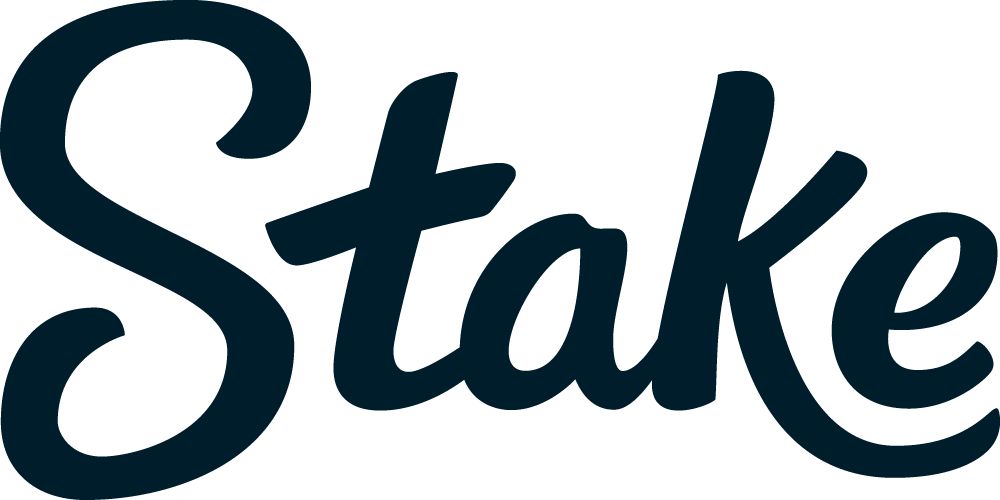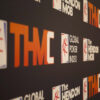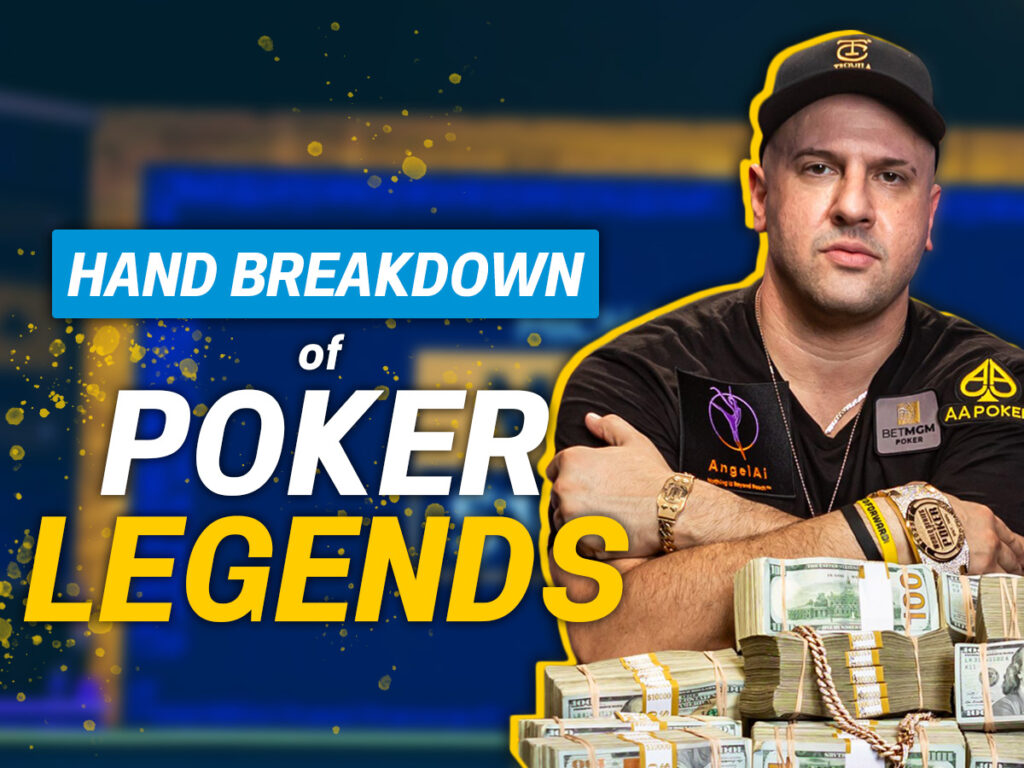
Welcome to the Hand Breakdown Series of Poker Legends with lead strategist Aytan Eldarova. Today we’ve got a real treat – we’re revisiting one of the most iconic WSOP final table moments from none other than Michael “The Grinder” Mizrachi. A true force of nature at the felt, Mizrachi’s fearless aggression and ability to close when it matters most have made him one of the most decorated and respected champions in poker history.
And to help us break it all down, we’re joined by a living legend in his own right – Dara O’Kearney. Widely regarded as one of the greatest ICM minds in the game, Dara has built a reputation as both a world-class competitor and an educator whose insights have shaped how modern tournament players think about poker. His blend of razor-sharp analysis and deep respect for the game makes him the perfect voice to walk us through Mizrachi’s brilliance.
- Read more: The Grinder’s Greatest Hour, Michael Mizrachi Wins 2025 WSOP Main Event and Joins Poker Immortality
Hand Overview / HAND 1 / Blind vs. Blind Decision-Making
Stage: 2025 WSOP Final Table – 8/9,735
Players: John Wasnock (SB): 143.8M (~90 BB), Michael Mizrachi (BB): 93M (~58 BB)
Blinds: 800K / 1.6M with 1.6M ante
Effective Stack: 58 BB
Pot After Antes/Blinds: 4.8M
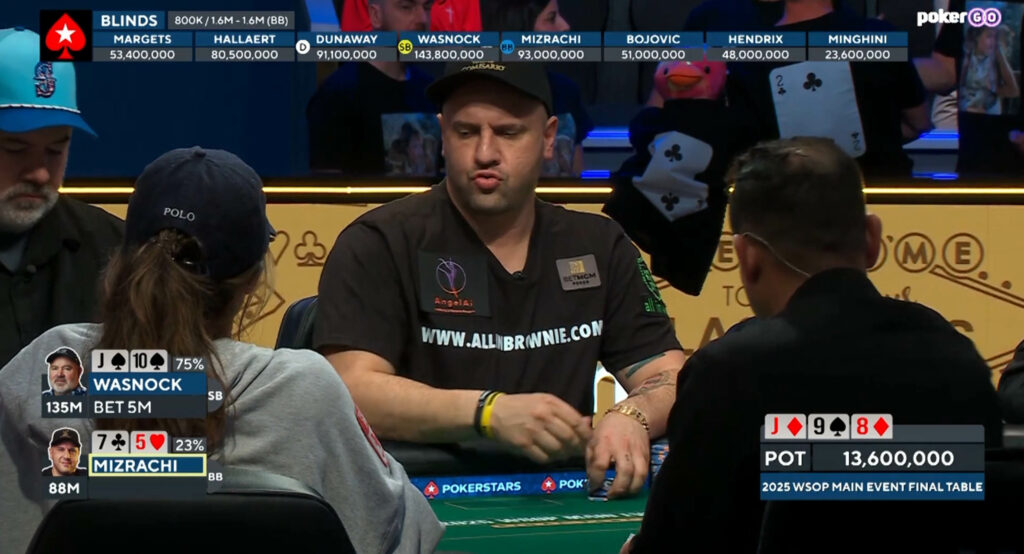
Street-by-Street Breakdown with Analysis
Preflop
Action: Wasnock raises to 3.5M with J♠10♠ (standard and strong open). Mizrachi calls with 7♣5♥.
Analysis: Wasnock’s open is standard and strong. JTs is a highly playable hand in blind vs. blind – suited, connected, and has strong equity heads-up. Sizing is good – just over 2x, keeps Mizrachi’s range wide. Mizrachi’s call is defensible even though 7♣5♥ is weak, but playable in position vs. a wide SB open. Given Mizrachi’s post-flop ability and deep stacks, calling to play a pot in position is reasonable. In blind-vs-blind play, ranges widen dramatically. Mizrachi’s loose defend is part of balanced post-flop aggression and exploit potential.
Dara O’Kearney: In BvB battles, defending wide like this is key discourages steals, and this stack depth allows for additional post flop exploits without overcommitting from an ICM perspective.
Flop J♦9♠8♦
Action: Wasnock bets 5.1M into 8.6M, Mizrachi folds.
Analysis: Wasnock hits top pair with open-ended straight draw – a very strong hand on this coordinated board. Mizrachi flops nothing but a backdoor straight possibility – 6 for the gut shot, no diamond draw, no pair. Wasnock’s 5.1M c-bet (~60% pot) has perfect sizing that forces fold equity vs. most non-pair, non-diamond hands. Builds pot with strong equity and protects against two-over and flush draw combinations. Mizrachi’s fold is completely standard. With no draw, no pair, and bad board texture, he rightly lets it go. Strong top pair + draw hands deserve immediate value betting. Wasnock’s sizing is perfect to apply pressure and deny equity.
Dara O’Kearney: On connected boards, aggressors should bet bigger to protect equity-60% is spot-on for denying cheap draws in deep-stack spots.
Strategic Verdict: While simple, this hand shows classic blind vs blind dynamics. Wasnock uses aggression and board advantage to end the hand early. Mizrachi doesn’t force marginal spots and conserves chips – a hallmark of deep-run tournament discipline.

Hand Overview / HAND 2 / 3-Bet Dynamics vs. Wide Opens
Stage: 2025 WSOP Final Table – 8/9,735
Players: Michael Mizrachi (CO): 87.1M (≈54 BB), Adam Hendrix (SB): 44.8M (≈28 BB)
Blinds: 800K / 1.6M with 1.6M ante
Effective Stack: ~28 BB
Initial Pot: 6.4M
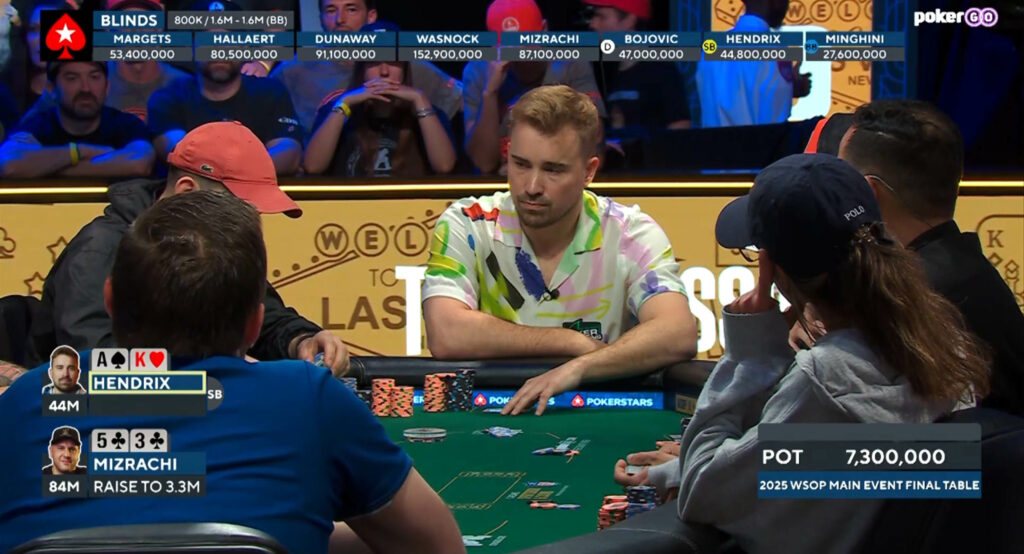
Street-by-Street Breakdown with Analysis
Preflop
Action: Mizrachi opens to 3.3M from the cutoff with 5♣3♣. Hendrix 3-bets to 13.2M from the small blind with A♠K♥. Mizrachi folds. Pot before fold: 17.9M
Analysis: Mizrachi’s open 5♣3♣ in CO is ultra-loose, even for an aggressive player like Mizrachi. Likely a calculated steal attempt: blinds are up, he has a mid-sized stack, and he’s in a steal-friendly position CO. Suited connectors even gapers offer post-flop playability, especially when you’re the preflop aggressor. Cutoff opens can include suited wheel cards in tournament settings – especially when targeting tight players in the blinds. But hands like 5♣3♣ are very thin, particularly against aggressive 3-bettors. Hendrix’s 3-Bet with A♠K♥ in SB is a textbook response. AK offsuit is a premium hand, especially against a likely wide CO open. Sizing to 13.2M – 4x the raise is perfect with 28 BB behind – it applies max pressure while keeping fold equity alive. He cuts off the positional advantage Mizrachi would otherwise exploit. At ~25–30 BB, AK plays best as a 3-bet or shove, not a flat. Hendrix plays it optimally – building the pot and possibly taking it down pre.
Dara O’Kearney: At 25-30BB, 3-betting premiums like AK is mandatory – flatting invites trouble with ICM pressure building at final tables.
Mizrachi’s fold once faced with a large 3-bet, Mizrachi has an easy fold. His hand is garbage against Hendrix’s value or polarised range, and he’s out of position post-flop if he calls. Importantly, he doesn’t force action – he tried a steal, got resistance, and let it go. Aggressive openers must fold to resistance with weak hands. Discipline is part of the strategy – knowing when the play didn’t work and moving on.
Strategic Verdict: This is a classic steal vs. resistance scenario: Mizrachi applies pressure with a loose open, testing the table, Hendrix responds with optimal 3-bet sizing and range forcing a fold. The hand ends preflop, but the strategy is clear: leverage position and stack sizes to push small edges and importantly know when to back down when you’re beat.
Hand Overview / HAND 3 / Early Position Dynamics + Post flop Discipline
Stage: 2025 WSOP Final Table – 7/9,735
Players: Michael Mizrachi (UTG): 83.8M (~52 BB), Luka Bojovic (UTG+1): 47M (~29 BB)
Blinds: 800K / 1.6M with 1.6M ante
Effective Stack: ~28 BB
Initial Pot: 6.4M
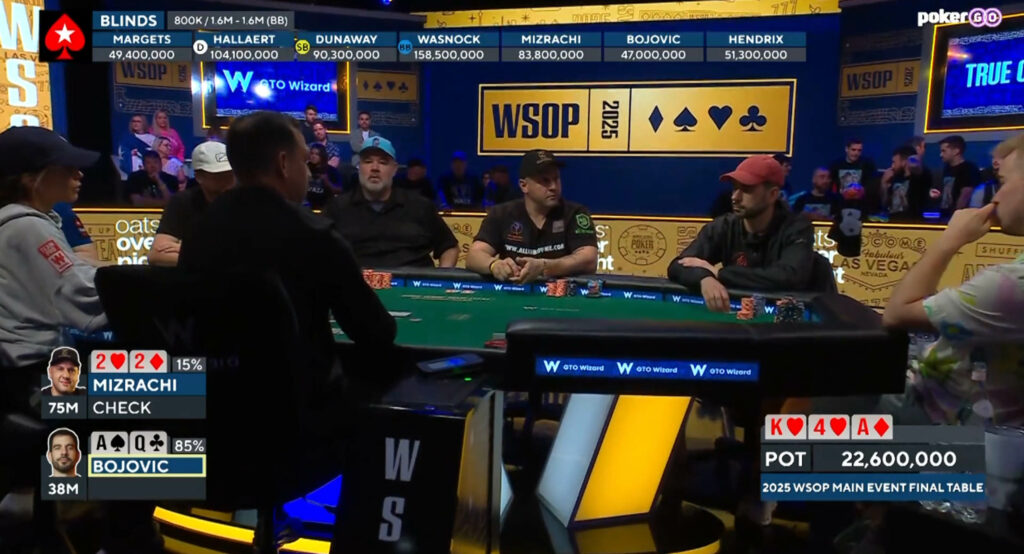
Street-by-Street Breakdown with Analysis
Preflop
Action: Mizrachi raises to 3.3M UTG with 2♥2♦. Bojovic 3-bets to 9.3M with A♠Q♣ in UTG+1. Mizrachi calls. Pot: 22.6M
Analysis: Mizrachi’s Open 2♥2♦ UTG is very bottom of opening range – this is a marginal but defensible open, especially for a player like Mizrachi who mixes low pairs into early position ranges. With over 50 BB, Mizrachi can afford to take these spots looking to set-mine or apply ICM pressure post-flop. Low pairs from UTG should be played carefully. Their value comes from hitting a set or navigating dry boards – not showdown strength.
Dara O’Kearney: You’re set-mining too much if you call all low pairs like 22 OOP – implied odds aren’t there at these depths, better to fold pre. Grinder presumably knows this but expects to over realise post flop due to perceived skill edge.
Bojovic’s 3-Bet with A♠Q♣ UTG+1 is standard and strong. AQ offsuit is a clear 3-bet candidate, especially facing an early-position raiser with a wide, possibly unbalanced range. The 9.3M sizing (2.8x) is ideal given his ~29 BB stack: large enough to apply pressure, small enough to preserve fold equity and stack utility. AQ is a strong 3-bet hand in mid-stacks. You’re often ahead of opener’s range and can extract value or force folds. Mizrachi’s call flatting 22s out of position vs. a 3-bet is very marginal. This play assumes Bojovic is wide enough that Mizrachi can either hit a set or outplay him post-flop. It’s a set-mine or float attempt, but comes with risk – Mizrachi is out of position and with a vulnerable hand. Calling small pairs vs. 3-bets only makes sense with deep stacks and clear implied odds. With 30–50 BB, this is often a fold or sometimes a 4-bet bluff but not with 22.
Flop K♥4♥A♦
Action: Mizrachi checks, Bojovic bets 4.5M into 22.6M, Mizrachi folds.
Analysis: Two broadway cards KA and two hearts – very favourable for the 3-bettor’s range. Mizrachi has no pair, no draw, no backdoors – just air. Bojovic hits top pair with strong kicker AQ and bets small – a quarter-pot stab designed to protect his equity and possibly induce loose calls. Low flop c-bets 15–25% are effective in 3-bet pots on dry ace-high boards. You deny equity and build the pot without risking much.
Dara O’Kearney: Small c-bets in 3-bet pots exploit capped range perfectly – math shows they fold out enough to be +EV.
Strategic Verdict: This hand demonstrates Bojovic’s well-timed pressure with AQ and his understanding of stack-aware 3-bet sizing. Mizrachi’s discipline to give up on a flop that crushes his range and offers no path forward. While it was a small pot, this is a great example of range awareness, discipline, and stack-sensitive aggression.

Hand Overview / HAND 4 / Float Play and Turn Lead Bluff
Stage: 2025 WSOP Final Table – 7/9,735
Players: Kenny Hallaert (CO): 104.1M (~65 BB), Michael Mizrachi (BB): 74.5M (~47 BB)
Blinds: 800K / 1.6M with 1.6M ante
Effective Stack: ~47 BB
Initial Pot: 4.8M
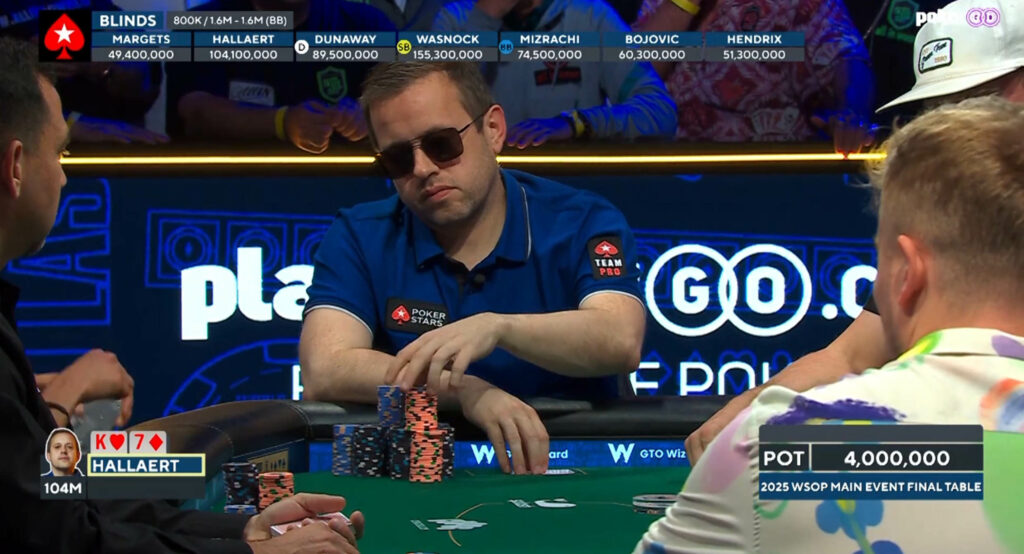
Street-by-Street Breakdown with Analysis
Preflop
Action: Hallaert raises to 3.5M in the cutoff with K♥7♦. Mizrachi calls 1.9M more from the BB with A♣3♣. Pot: 9.4M
Analysis: Hallaert’s open K♥7♦ in CO is a light open, but acceptable from late position with over 60 BB. K7 offsuit isn’t strong, but can be used to pressure the blinds, especially with ICM implications mid-final table. Late-position open ranges should include suited and offsuit broadway blockers like K7 when blinds are likely to fold or play passively. Mizrachi’s call A♣3♣ in BB is a solid defence because he has his suited ace, good blockers, and some post-flop manoeuvrability. Mizrachi is likely to call here not just to hit, but to exploit positional advantage post-flop. Suited aces are standard BB defence hands. They can float flops, block value combos, and bluff effectively later.
Flop 8♥2♦9♣
Action: Mizrachi checks, Hallaert bets 3.2M, Mizrachi calls. Pot: 15.8M
Analysis: Medium and disconnected – favours the big blind’s flatting range lots of 8x, 9x, 7x, 6x, and pocket pairs. Hallaert has two overcards but no backdoors – this is a low-frequency c-bet, but he tries to take it down early. Mizrachi has ace high and position, and calls the small c-bet likely planning to float and apply pressure later. Flop floats with ace-high are powerful when you believe opponent’s range is weak or capped, especially when you’re in position and can represent strong hands later.
Dara O’Kearney: Floating with suited aces in BB exploits weak c-bets – ICM favours position here for turn aggression.
Turn 8♦
Action: Mizrachi leads for 4.6M, Hallaert folds, Mizrachi wins the pot.
Analysis: Turn pairs the board, making it less likely Hallaert connected with flop unless he has an 8 or overpair – both unlikely after a small c-bet. Mizrachi turns the hand into a bluff, leading small about 29% pot – a savvy move, since the paired board hits his perceived range e.g., 8x, 9x, 22, 98. Hallaert likely gives up with king high, recognising he has no equity or fold resistance. Donk leads on turn are effective when the board changes in a way that favours the caller’s range. Mizrachi exploits this perfectly.
Dara O’Kearney: Donk leads on paired turns which shift range advantage – low sizing maximises fold equity without over-risking.
Strategic Verdict: This hand shows elite-level post-flop awareness from Mizrachi – he uses ace-high as a bluff catcher on the flop. Recognises the paired turn favours his range, and executes a well-timed low-stakes bluff to take the pot. Meanwhile, Hallaert’s c-bet with air wasn’t terrible – but without follow-up or board improvement, his early aggression gets defused by superior post-flop play.
Hand Overview / HAND 5 / 3-Bet Bluff vs. Premium 4-Bet
Stage: 2025 WSOP Final Table – 7/9,735
Players: Braxton Dunaway (MP): 100.2M (~63 BB), Michael Mizrachi (BB): 77.2M (~48 BB)
Blinds: 800K / 1.6M with 1.6M ante
Effective Stack: 48 BB
Initial Pot: 6.4M
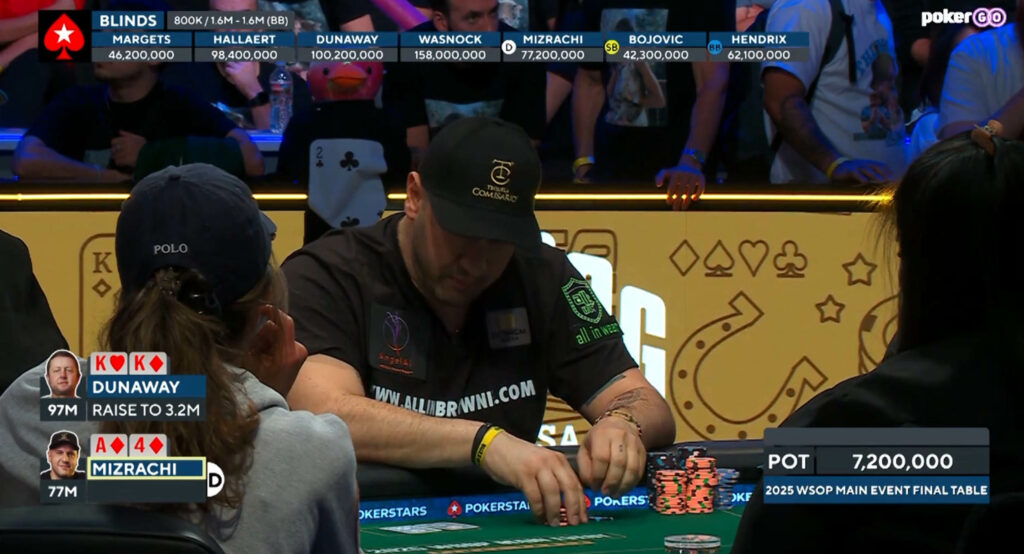
Street-by-Street Breakdown with Analysis
Preflop
Action: Dunaway raises to 3.2M in middle position with K♥K♦, Mizrachi 3-bets to 8.6M from the BB with A♣4♣, Dunaway 4-bets to 35M, Mizrachi folds, Dunaway wins pot 12.6M.
Analysis: Dunaway’s open K♥K♦ in MP is a standard raise from middle position with a premium pair. KK is well ahead of the entire table’s range and plays great in both single-raise and 3-bet pots. Premium pairs QQ+ should nearly always be opened for value – especially at final tables, where opponents are tightening up due to ICM. Mizrachi’s 3-bet with A♣4♣ from BB. A♣4♣ is a classic suited bluff candidate – it blocks strong hands aces, is suited for equity, and avoids domination from mid-to-low Ax. Mizrachi is using his stack depth of 48 BB to apply pressure on a likely wide MP open. In late stages, suited Aces make great 3-bet bluffs. They block 4-bet jams, and if called, have post flop playability.
Dara O’Kearney: Suited aces like A4s are ideal 3-bet bluffs – blockers reduce villain’s premiums, but we can fold to resistance as ICM dictates.
Dunaway’s 4-Bet to 35M. Perfect sizing for a 4-bet ≈4x Mizrachi’s 3-bet. This is a defensive and value-driven 4-bet. It either takes down the pot preflop or sets up a shallow stack-to-pot ratio for post flop all-ins with KK. He protects his premium holding and punishes potential bluff 3-bets. Against active players, 4-betting premiums like KK serves both protection and value extraction. Make the sizing too small, and you invite floats or awkward flops. Mizrachi’s Fold is smart and disciplined. He realises his 3-bet didn’t work, and now he’s facing a massive 4-bet. A♣4♣ can’t call or shove against that sizing – it’s a classic 3-bet/fold hand. Preflop bluffs must come with a fold plan. Mizrachi’s fold is exactly right – aggression must stop when it runs into credible resistance.
Strategic Verdict: This is a great example of balanced tournament strategy on both sides: Dunaway played his KK exactly right – protecting his hand, reapplying pressure, and keeping Mizrachi from realising equity. Mizrachi ran a well-timed 3-bet bluff with a proper hand type but didn’t force it once challenged – a mark of elite discipline. No chips were exchanged post-flop, but the hand still demonstrated top-tier play in a pressure-heavy spot.

Hand Overview / HAND 6 / Preflop Pressure & Flop Continuation
Stage: 2025 WSOP Final Table – 7/9,735
Players: Michael Mizrachi (MP): 68.6M (~34 BB), Kenny Hallaert (BB): 98.4M (~49 BB)
Blinds: 1M / 2M with 2M ante
Effective Stack: 34 BB
Pot Preflop: 7M
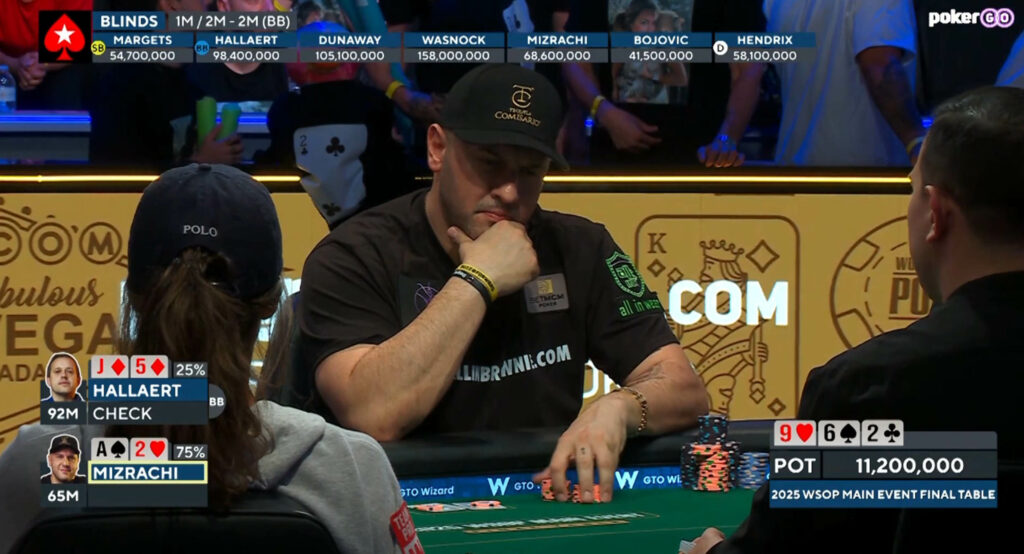
Street-by-Street Breakdown with Analysis
Preflop
Action: Mizrachi raises to 4.1M from MP with A♠2♥, Hallaert calls in the BB with J♦5♦. Pot: 11.2M
Analysis: Mizrachi opens A♠2♥ in MP. Suited wheel aces are playable in mid-position when stacks are moderate (30–40 BB). A2 offsuit is borderline but Mizrachi likely factors in his image, table dynamics, and blind tendencies to justify the open. In final table play, suited aces are strong open candidates, but offsuit versions like A2o are marginal. Mizrachi balances his range and applies pressure.
Dara O’Kearney: Offsuit wheel aces like A2o are marginal opens in MP – ICM suggests tightening vs. deep BB defenders.
Hallaert calls J♦5♦ in BB. Suited J5 is a standard defence versus a ~2.05x open. He has position post-flop and good board coverage against an MP opening range. Big blind defence widens considerably when facing small raises. Suited hands have equity and playability, even when weak.
Flop 9♥6♠2♣
Action: Hallaert checks, Mizrachi bets 3M ~27% pot, Hallaert folds.
Analysis: Relatively dry, low-connectivity board. Mizrachi hits bottom pair 2s – vulnerable but likely ahead of most non-pair hands. Hallaert completely misses the board with J-high and no backdoors. Small flop bets 25–33% pot are powerful tools in position on dry boards. They fold out hands with 25–35% equity and give you information.
Dara O’Kearney: Small c-bets on dry flops are +EV math – low risk, high fold rate against capped ranges.
Strategic Verdict: This hand is a clean example of modern tournament fundamentals: Mizrachi opens light but plays it well – c-bets small to protect weak pair and fold out air. Hallaert defends wide, which is correct, but folds smartly when he misses and faces a flop stab. While small in pot size, this hand highlights how players accumulate chips through frequent small wins, not just big showdowns.
Hand Overview / HAND 7 / Multi-Level Preflop Premium Collision & Deep ICM Implications
Stage: 2025 WSOP Final Table – 7/9,735
Players: Braxton Dunaway (CO): 85.1M (~43 BB), John Wasnock (BTN): 182M (~91 BB), Michael Mizrachi (SB): 71.7M (~36 BB)
Effective Stack: 36 BB (Mizrachi)
Pot Preflop: 151.4M
Final Board: 9♥7♦J♠Q♣A♦
Winner: Mizrachi with A♠K♦ (rivered top pair)
Wasnock: K♠K♣ – cracked
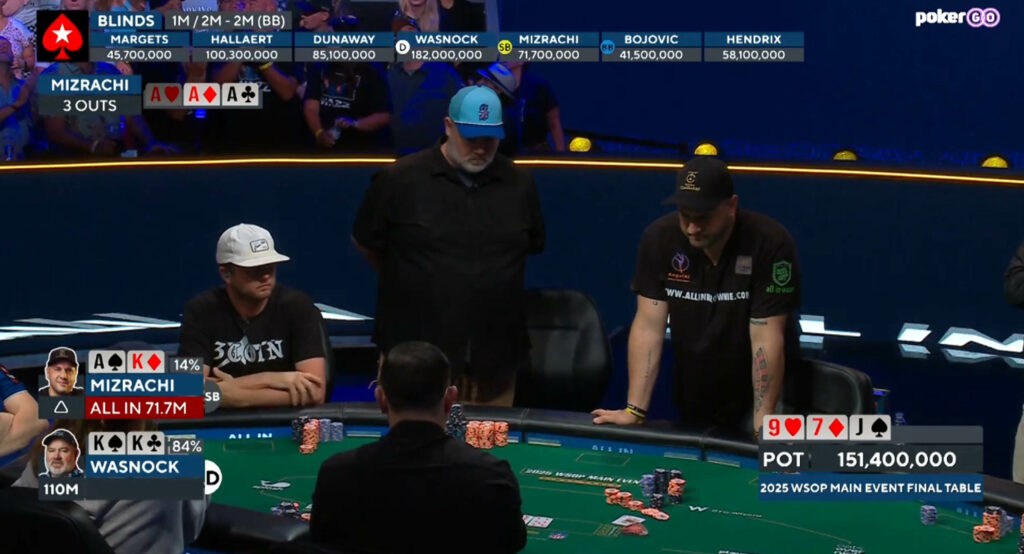
Street-by-Street Breakdown with Analysis
Preflop
Action: Dunaway opens to 4M in the cutoff with Q♦9♣, Wasnock 3-bets to 10M on the button with K♠K♣, Mizrachi cold 4-bets to 30M from the small blind with A♠K♦, Dunaway folds, Wasnock 5-bet shoves, Mizrachi calls (for 71.7M total). Pot: 151.4M
Analysis: Dunaway’s Open – Q♦9♣ from CO. Standard light open from late position. At ~43 BB, Q9o is part of a wide opening range, but he quickly gets out of the way when facing major action behind. Always be ready to release light opens when aggressive players are behind, especially near ICM-sensitive spots. Wasnock’s 3-Bet – K♠K♣ on BTN. Premium hand in position – standard 3-bet. Sizing to 10M is small 2.5x, a common tactic to keep ranges wide and extract value from worse hands. At final tables, flatting with KK is rare on the button – Wasnock sets a trap while still building the pot against a wide cutoff open. Mizrachi’s 4-Bet – A♠K♦ from SB. AK suited or offsuit is top of the 4-bet/call range. Sizing to 30M from 71.7M stack is committing ~42% of stack, essentially forcing a call vs. a jam. With AK at ~35–40 BB, you don’t flat 3-bets – you 4-bet to isolate or induce. Mizrachi plays this spot perfectly, targeting BTN bluffs and light 3-bets.
Dara O’Kearney: Cold 4-bets from SB with AK are ICM gold – dominates bluffs, and pot odds make calling shoves unavoidable.
Wasnock’s 5-Bet Shove with KK. Correct play. Once Mizrachi cold 4-bets, Wasnock applies maximum ICM pressure with the 2nd-best starting hand. He covers Mizrachi and forces him to commit his tournament life – a brilliant and technically correct shove. When deep-stacked at final tables, premium hands should play fast. Shove to eliminate variables and deny equity to hands like AQ, JJ, AK. Wasnock’s 5-Bet Shove with KK. Correct play. Once Mizrachi cold 4-bets, Wasnock applies maximum ICM pressure with the 2nd-best starting hand. He covers Mizrachi and forces him to commit his tournament life – a brilliant and technically correct shove. When deep-stacked at final tables, premium hands should play fast. Shove to eliminate variables and deny equity to hands like AQ, JJ, AK. Mizrachi’s Call with his tournament life on the line. Mizrachi correctly identifies AK as too strong to fold. He commits knowing he is either flipping vs. QQ/JJ, dominating AQ, or crushed by AA, KK – but mathematically cannot fold given pot odds and his stack commitment. With AK vs. a 5-bet jam, pot odds + hand strength justify the call even at a final table. Tight folds here are losing plays long term.
Board runout: 9♥7♦J♠Q♣A♦ – Mizrachi hits top pair Aces on the river, cracking Wasnock’s kings.
Dara O’Kearney: Final table coolers like KK vs AK are pure variance – both sides played optimally per ICM math.
Strategic Verdict: This hand is a classic final table premium showdown, with textbook aggression and discipline from both Wasnock and Mizrachi. Wasnock applied pressure correctly, extracted value, and played KK fast. Mizrachi cold 4-bet appropriately and didn’t flinch when faced with a shove. The result – a 70+ BB pot and massive momentum shift to Mizrachi – all built on sound decisions.
Hand Overview / HAND 8 / Passive Lines, Missed Value & Pot Control
Stage: 2025 WSOP Final Table – 7/9,735
Players: Michael Mizrachi (BTN): 151.4M (~76 BB), Adam Hendrix (BB): 58.1M (~29 BB)
Blinds: 1M / 2M with 2M ante
Effective Stack: 29 BB
Pot Size Preflop: 11.2M
Final Board: 8♥Q♦6♥J♠8♦
Result: Split Pot (both hold showdown value with a pair of eights and Queen-Jack kicker)
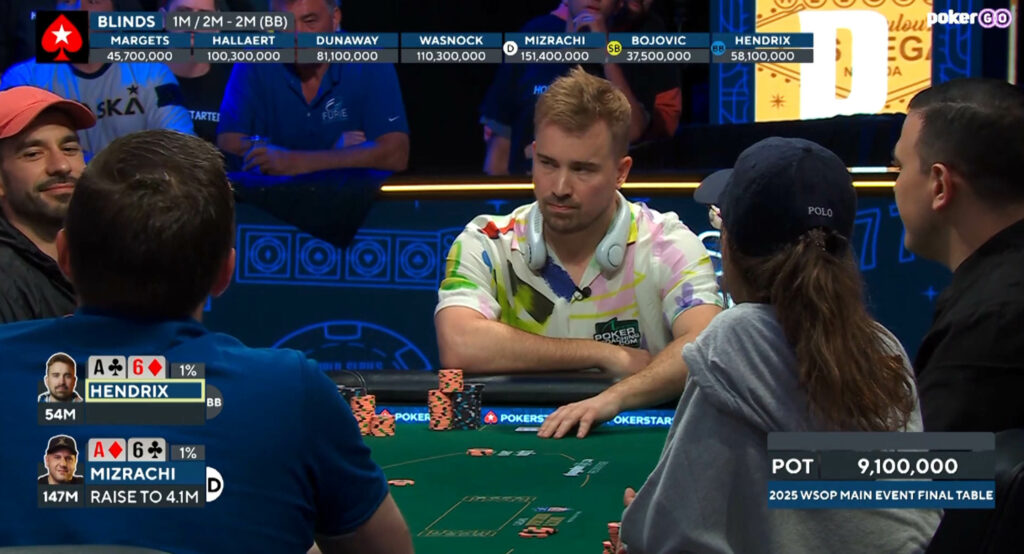
Street-by-Street Breakdown with Analysis
Preflop
Action: Mizrachi raises to 4.1M on the button with A♦6♣, Hendrix calls 2.1M more from the BB with A♣6♦. Pot: 11.2M
Analysis: Mizrachi’s open A♦6♣ on the BTN is standard open with a weak offsuit ace. Uses positional advantage to apply pressure on a ~29 BB stack in the big blind.Offsuit Aces are excellent opens on the button – they block premium hands and perform reasonably post flop due to kicker strength and fold equity. Hendrix’s call – A♣6♦ in BB. Standard defence – suited or offsuit Ace-x hands defend profitably vs. small BTN opens at 25–30 BB depth. Calls to see a flop rather than 3-betting with a hand that plays poorly if shoved on. Ace-x hands are natural BB defence candidates. They block strong top-end hands and can hit top pair or bluff-catching hands post flop.
Flop 8♥Q♦6♥
Action: Hendrix checks, Mizrachi checks back. Both players hold bottom pair – sixes with Ace kicker.
Analysis: Wet, mid-high board with two hearts – potential for draws. Both players under-represent their hand: neither wants to inflate the pot with weak top pair / bottom pair holdings. Mizrachi’s check is a form of pot control + equity protection. With weak one-pair hands in position, checking back can be optimal – you deny bluffing opportunities while still reaching showdown.
Dara O’Kearney: Pot control with marginal pairs on wet boards is smart – avoids bloating pots where ICM punishes variance.
Turn J♠
Action: Check, check again.
Analysis: Turn brings another over card J, weakening the strength of both players’ pair of sixes. Still no bets – both players seem content to take the hand to showdown. If either player had a draw or two pair, we’d expect a delayed c-bet or lead. On increasingly dangerous boards, marginal made hands often downgrade to pure bluff catchers or check-folds. Avoid turning them into bluffs if not credible.
River 8♦
Action: Check, check again. Both players have two pair 8s and 6s. Pot is split.
Analysis: Neither player tries to bluff or extract thin value – a disciplined decision given kicker equivalence is impossible to detect. With paired boards and no betting throughout, checking down is safest. When both ranges are capped and the pot is small, taking your equity to showdown is often better than risking thin bluffs with no information advantage.
Strategic Verdict: This hand is a textbook example of disciplined tournament poker: Both players open and defend correctly preflop. They take passive but appropriate lines post flop with weak showdown value. No chips are wasted chasing marginal value or bluffing into uncertainty. No risk taken, no mistakes made – just clean, controlled poker between two final table veterans.
Hand Overview / HAND 9 / Range Advantage & C-Bet Pressure
Stage: 2025 WSOP Final Table – 7/9,735
Players: Michael Mizrachi (CO): 152.9M (~76 BB), Leo Margets (BB): 45.7M (~23 BB)
Blinds: 1M / 2M with 2M ante
Effective Stack: 23 BB
Pot Preflop: 11.2M
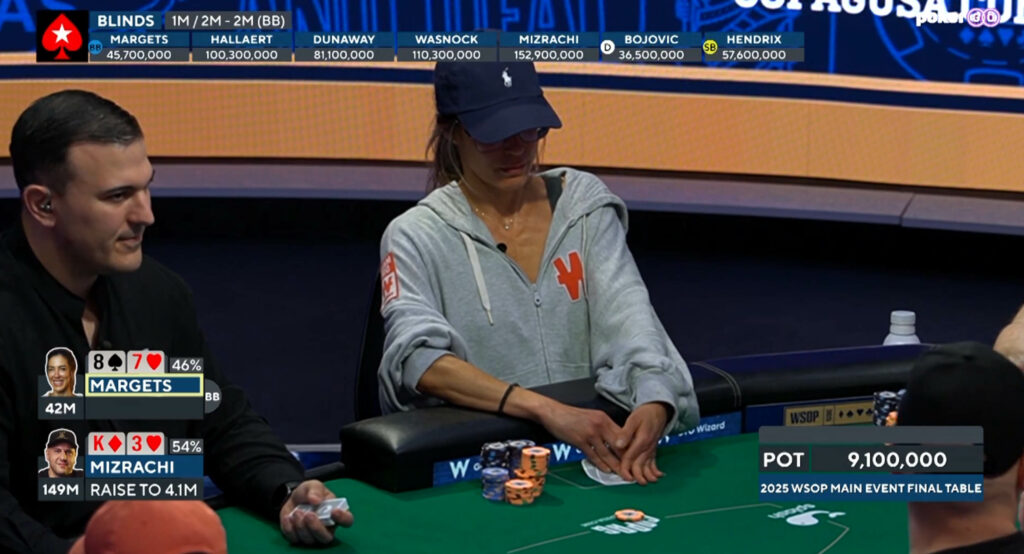
Street-by-Street Breakdown with Analysis
Preflop
Action: Mizrachi raises to 4.1M in the cutoff with K♦3♥. Margets calls 2.1M more from the big blind with 8♠7♥. Pot: 11.2M
Analysis: Mizrachi’s Open K♦3♥ from CO – loose, but not out of line for Mizrachi, who’s leveraging his big stack and position. K3 offsuit is near the bottom of the cutoff range, but applying pressure to mid-short stacks in the blinds is standard at final tables. In ICM-heavy spots, big stacks should open wide from late positions to steal blinds and antes – especially against players who can’t easily 3-bet or call light.
Dara O’Kearney: Big stacks should widen opens in CO for ICM leverage – but watch for short-stack re-shoves.
Margets’ call with 8♠7♥ in BB is a reasonable defence. 8♠7♥ connectors have some playability, but this version is offsuit and weak. At ~23 BB, Margets might prefer to fold here, as hands like 87o are low equity vs. wide but high-card-heavy ranges. Given ICM pressure, this is likely a marginal call, slightly too loose unless there’s a specific read. BB defence at final tables must be tighter than normal – speculative hands like 87o often struggle vs. aggression and wide value-heavy opens.
Flop Q♠5♥A♣
Action: Margets checks, Mizrachi bets 2.2M ≈20% pot. Margets folds.
Analysis: Very dry, high-card-heavy – favours the raiser’s range heavily. Mizrachi has complete range advantage: he easily represents Ax, broadway combos, AQ, KQ, etc. Margets completely whiffs – no pair, no draw, no backdoor equity. Small flop c-bets ~20–30% pot are extremely effective on ace-high boards when you have range advantage and the caller is capped.
Dara O’Kearney: Ace-high flops give raisers huge range edge – tiny c-bets print money vs. capped defenders.
Strategic Verdict: This hand may seem uneventful, but it demonstrates two core tournament principles in action: Mizrachi uses stack leverage and range advantage to pick up chips with a minimal investment. Margets, facing ICM pressure and holding air, rightfully folds, avoiding deeper commitment out of position. Mizrachi wins a small but meaningful pot – the kind that separates chip accumulators from survivors.
Hand Overview / HAND 10 / Capped Ranges & Showdown Value
Stage: 2025 WSOP Final Table – 6/9,735
Players: Michael Mizrachi (MP) 160M (~80 BB), Dunaway (BB) 81.1M (~40.5 BB)
Blinds: 1M / 2M with 2M ante
Effective Stack: ~40.5 BB
Pot Preflop: 11.2M
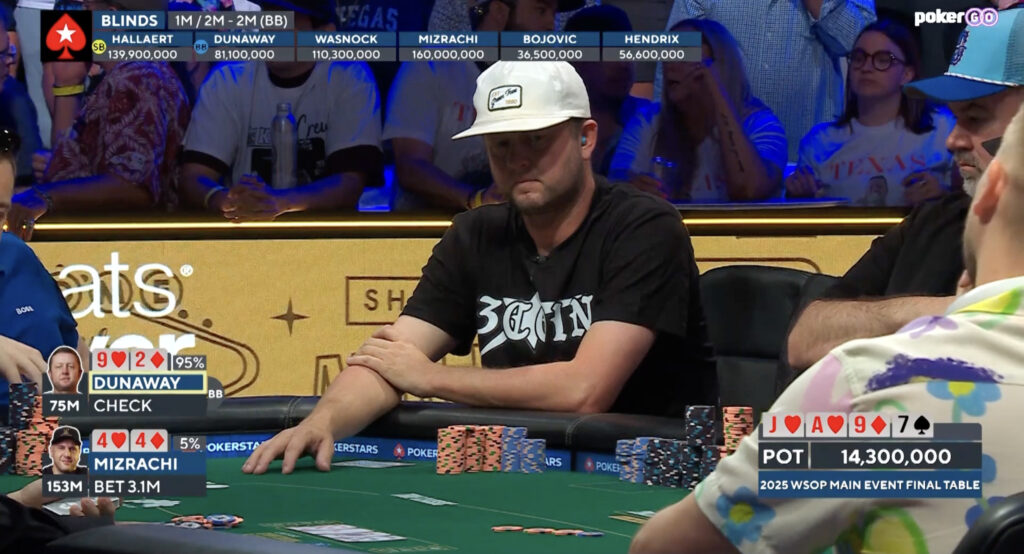
Street-by-Street Breakdown with Analysis
Preflop
Action: Mizrachi opens MP to 4.1M with 4♥4♦. Dunaway defends BB with 9♥2♦.
Analysis: Standard open for Mizrachi; 44 plays cleanly versus blinds and realises equity well post-flop. BB defend with 9 2 offsuit is extremely thin – likely an exploit vs. a smaller sizing and perceived wide open, but it starts the hand with serious reverse-implied odds.
Flop J♦A♥9♦
Action: Dunaway check (BB), check (Mizrachi).
Analysis: Texture smashes the BB’s defend range (lots of Ax/9x/diamond draws) and is rough for 44, which has little fold equity and poor barreling prospects. Checking back with pure showdown value and backdoor straight outs is disciplined.
Turn 7♠
Action: Dunaway check (BB), Mizrachi bets 3.1M; Dunaway calls. Pot: 17.4M.
Analysis: Nice delayed stab sizing (~18% pot). It targets auto-folds from Qx high, wheel draws, and random floats while keeping risk low. BB’s call with 9x or diamonds is standard – the turn improves many draws and pair+draws.
River K♦
Action: Check (BB), check (Mizrachi). Dunaway wins.
Analysis: River completes front-door diamonds and broadway. 44 has zero blocker advantage and poor bluffing candidates, so shutting down is correct. Given BB’s capped pre but uncapped post on this runout, value attempts are optimistic.
Strategic Verdict: On ace-high, diamond-heavy textures, low pairs shift from thin value to pot-control/showdown pieces. Delayed small stabs can print vs. auto-folds, but know when to hit the brakes on volatile rivers. ICM punishes marginal fires. The delayed min-stab is fine, but once the river improves so many ranges, conserving chips is worth more than thin heroics.
Dara O’Kearney: Adhering to ICM inevitably means having to fold hands that are plus EV for chips but minus EV for dollars, and in this case Mizrachi’s disciplined check on the river prioritises long-term tournament equity over marginal spots at the final table.

Hand Overview / HAND 11 / 4-Bet Shove vs. ICM
Stage: 2025 WSOP Final Table – 6/9,735
Players: Mizrachi (UTG) 152.8M (~76 BB), Hendrix (BB) 56.6M (~28.3 BB)
Blinds: 1M / 2M with 2M ante
Effective Stack: ~28.3 BB
Pot After Preflop All-in: 118.2M
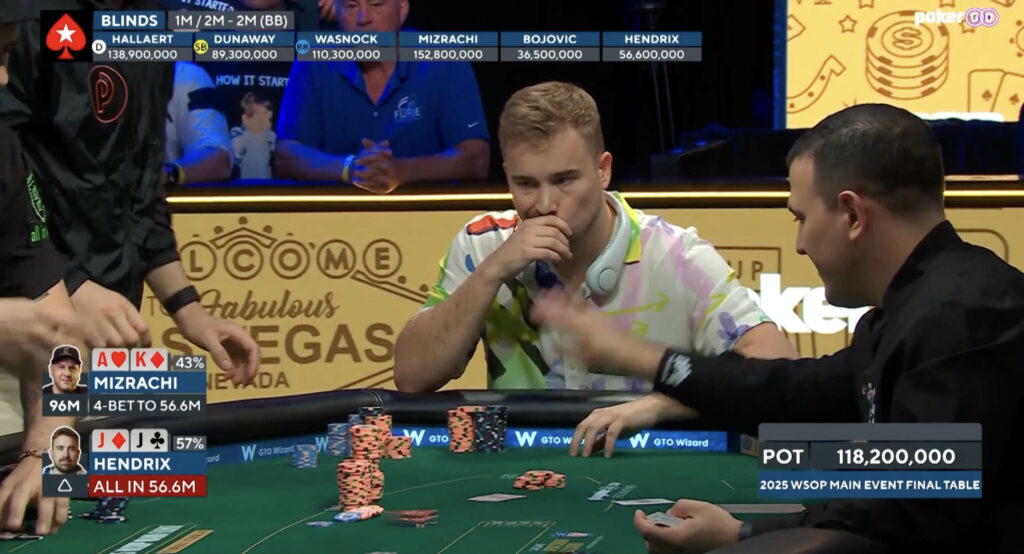
Street-by-Street Breakdown with Analysis
Preflop
Action: Mizrachi opens UTG to 4.3M with A♥K♦. Hendrix 3-bets BB to 12M with J♦J♣. Mizrachi 4-bet shoves; Hendrix calls off 56.6M.
Analysis: UTG open with AK is standard. BB’s 3-bet with JJ is mandatory at this depth to avoid brutal flops. Given stacks, AK’s 4-bet jam is the cleanest realisation of equity and maximises fold equity versus 99-QQ and AQ. From the BB, folding JJ to the shove is too tight at ~28 BB despite ICM – JJ is near the top of range and does well versus AK-heavy jams.
Board Q♣4♦Q♥K♠3♣
Result: King on turn flips the race; Mizrachi wins, Hendrix eliminated.
Strategic Verdict: With ~25-30 BB effective at a FT, the non-all-in 3-bet / fold line can be exploited. AK benefits massively from fold equity; JJ can’t overfold or it becomes a target. ICM pulls both ranges tighter, but BB can’t fold JJ to a competent UTG jam here. If you start folding this high in range, you’re giving up too much to the 4-bet shove.
Dara O’Kearney: If you play strictly by ICM you will end up folding a bit too much. There is an inflection point, the time comes where it is worth gambling for a big stack, which aligns with Hendrix’s call-off here, as folding JJ would surrender too much equity in pursuit of pure ICM preservation.
Hand Overview / HAND 12 / Cold 4-Bet Squeeze Discipline
Stage: 2025 WSOP Final Table – 5/9,735
Players: Mizrachi (SB) 210.4M (~105 BB), Hallaert (UTG) 148.9M (~74.5 BB), Dunaway (CO) 83.3M (~41.7 BB)
Blinds: 1M / 2M with 2M ante
Effective Stack: ~41.7 BB (vs. Dunaway)
Pot Result: 59.5M to Mizrachi preflop
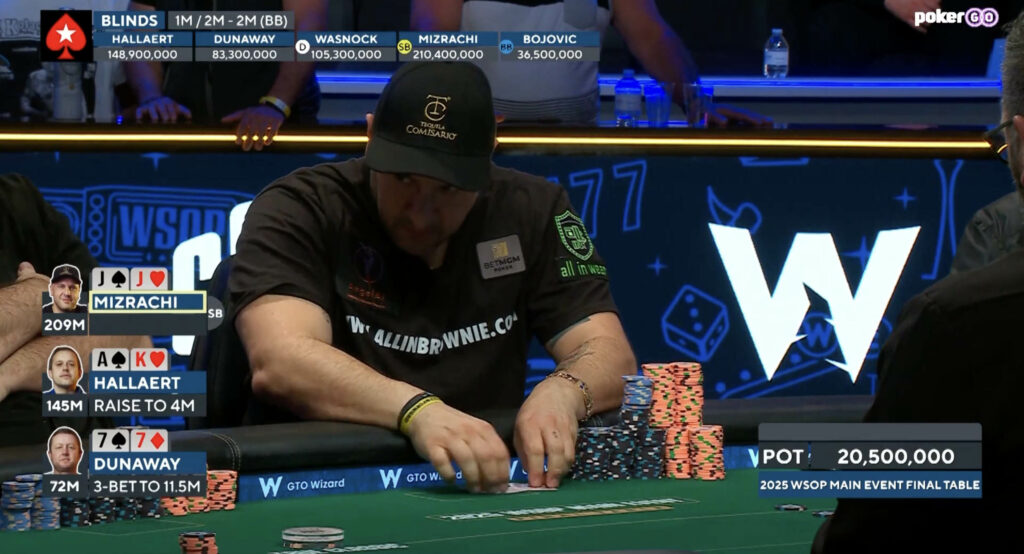
Street-by-Street Breakdown with Analysis
Preflop
Action: Hallaert opens UTG 4M with A♠K♥. Dunaway 3-bets CO to 11.5M with 7♠7♦. Mizrachi cold 4-bets SB to 40M with J♠J♥. Folds, folds.
Analysis: Textbook. UTG’s AK is standard. CO’s 77 3-bet targets isolation vs. UTG, but it’s thin under ICM. The SB cold 4-bet with JJ is premium: denies the CO’s realisation, leverages position on UTG post (if called), and uses sizing that pins 7x/88-TT/AQ into a miserable spot. Crucially, JJ avoids tough post-flops out of position by applying max pressure now.
Strategic Verdict: In ICM-heavy spots, premium pairs gain EV as cold 4-bet squeezes – they punish marginal 3-bets and cleanly realise equity without tricky flops. This is how you mint chips at a FT. JJ as a cold 4-bet is beautiful under ICM; it forces dominated pairs to surrender and prevents the deepest stacks from realising.
Dara O’Kearney: Mizrachi’s aggressive cold 4-bet here at the final table leverages ICM pressure to accumulate chips when opponents are tightening up.
Hand Overview / HAND 13 / Range Bet vs. Sticky Float
Stage: 2025 WSOP Final Table – 5/9,735
Players: Mizrachi (BTN) 229.9M (~115 BB), Hallaert (BB) 144.9M (~72.5 BB)
Blinds: 1M / 2M with 2M ante
Effective Stack: ~72.5 BB
Pot Preflop: 11.4M
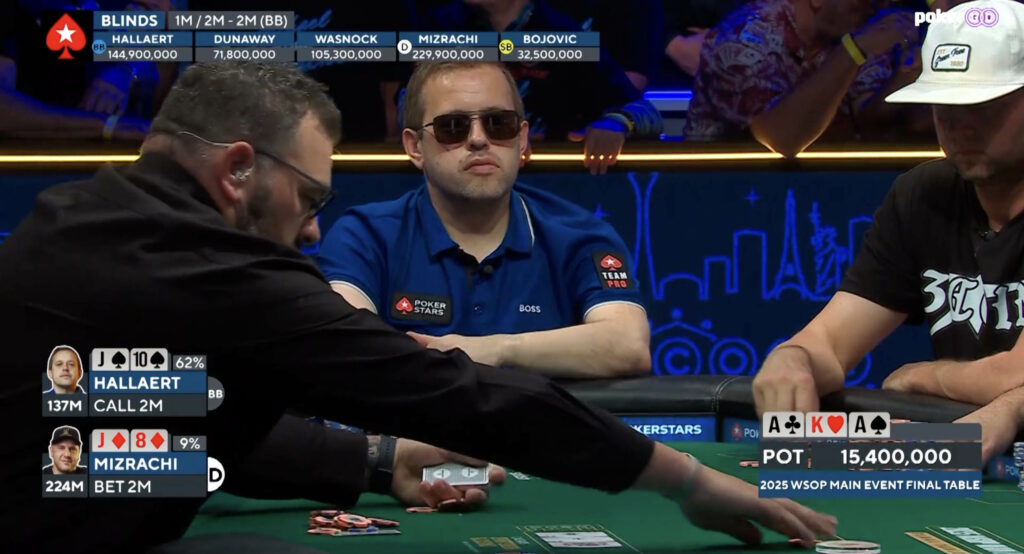
Street-by-Street Breakdown with Analysis
Preflop
Action: Mizrachi opens BTN to 4.2M with J♦8♦. Hallaert defends BB with J♠10♠. Pot 11.4M.
Analysis: Wide BTN open is standard; BB defend with JTs is slam-dunk.
Flop A♣K♥A♠
Action: Hallaert check (BB), Mizrachi 2M; call.
Analysis: Great board to range-bet tiny. BTN holds massive range advantage (all Ax/strong Kx), and the min-c-bet prints folds from air. BB’s call with backdoors/board coverage keeps ranges honest and sets up turn probes.
Turn 4♠
Action: Check, check.
Analysis: Once called, BTN’s J♦8♦ has no equity or blocker story; shutting down is optimal. BB keeps range uncapped while risking nothing.
River K♠
Action: Check, check. Hallaert wins.
Analysis: Double-paired, static river – value is thin and bluffs are unattractive for BTN. BB realises the equity edge by calling the flop and owns the showdown.
Strategic Verdict: Tiny range bets on paired ace–king boards are high-frequency, but you must abandon ship once peeled and your hand lacks improvement or credible blockers. Minimal risk, maximum pressure on the flop – then disciplined shutdown. That’s the equilibrium approach on A-high, paired textures.
Dara O’Kearney: Entire generations learn ICM almost by rote… but not the why. The why here is that disciplined give ups like Mizrachi’s check-down preserve $EV over chasing thin chip EV.

Hand Overview / HAND 14 / Multiway Value-Protection Line
Stage: 2025 WSOP Final Table – 5/9,735
Players: Hallaert (CO) 165.6M (~82.8 BB), Wasnock (SB) 101.3M (~50.7 BB), Mizrachi (BB) 228.7M (~114.3 BB)
Blinds: 1M / 2M with 2M ante
Effective Stack: ~50.7 BB (multiway)
Pot Preflop: 17M
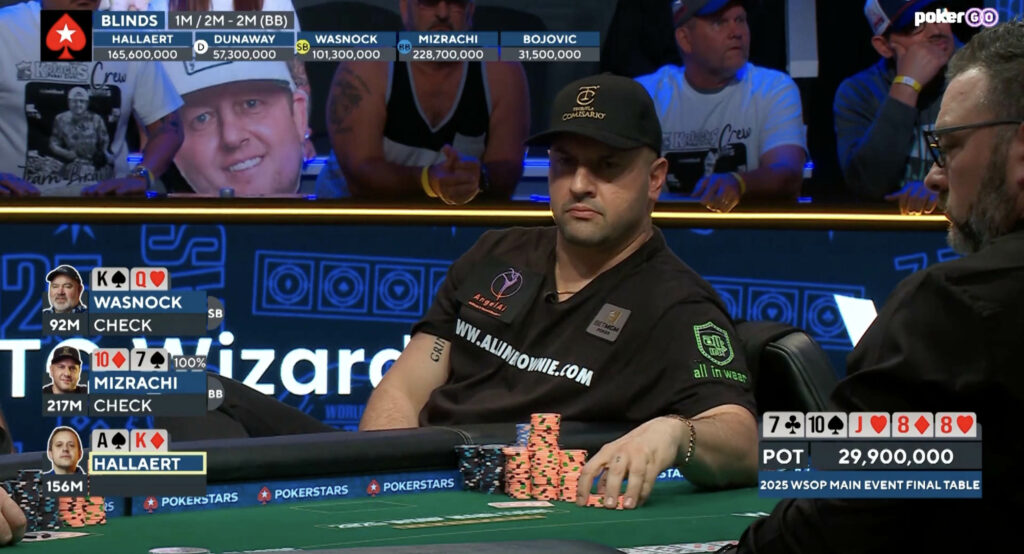
Street-by-Street Breakdown with Analysis
Preflop
Action: Hallaert opens CO 5M with A♠K♦. Wasnock calls SB with K♠Q♥. Mizrachi calls BB with 10♦7♠.
Analysis: Standard open; SB flat with KQ is fine under ICM. BB overcall with T7s takes price and plays well on dynamic boards.
Flop 7♣10♠J♥
Action: Check, check, check.
Analysis: Mizrachi flops two pair. Checking is sneaky and fine multiway: pot is protected by SB’s range, and the preflop raiser can stab often.
Turn 8♦
Action: Check (SB), Mizrachi 4.3M; Hallaert calls; SB calls. Pot: 29.9M.
Analysis: Small value/protection bet (~25% pot) is elegant: extracts from pair+draws (KQ, Q9, AQ with gutters) and denies equity to overcards. CO and SB have abundant straight draws – the small sizing keeps worse hands in while controlling variance.
River 8♥
Action: Check, check, check. Mizrachi wins.
Analysis: Board pairs, straight draws miss, but value narrows; overcalls from better two pairs/boats exist. Checking secures a high-EV showdown and avoids thin value into two ranges with ICM pressure.
Strategic Verdict: Multiway, small turn bets with medium-strong hands capture value and protection without inflating variance; river discipline avoids donating to slow-played traps.Two callers and ICM? Take the pot-control line. You already printed by charging draws on the turn – no need to force a marginal river.
Dara O’Kearney: Plays like Mizrachi’s small turn bet to build equity without overcommitting in multiway pots where future equity looms large are even more effective with ICM.
Hand Overview / HAND 15 / Bluff-Catch Discipline on Paired Boards
Stage: 2025 WSOP Final Table – 5/9,735
Players: Mizrachi (UTG) 246.3M (~123 BB), Wasnock (BB) 104M (~52 BB)
Blinds: 1M / 2M with 2M ante
Effective Stack: ~52 BB
Pot Preflop: 11M
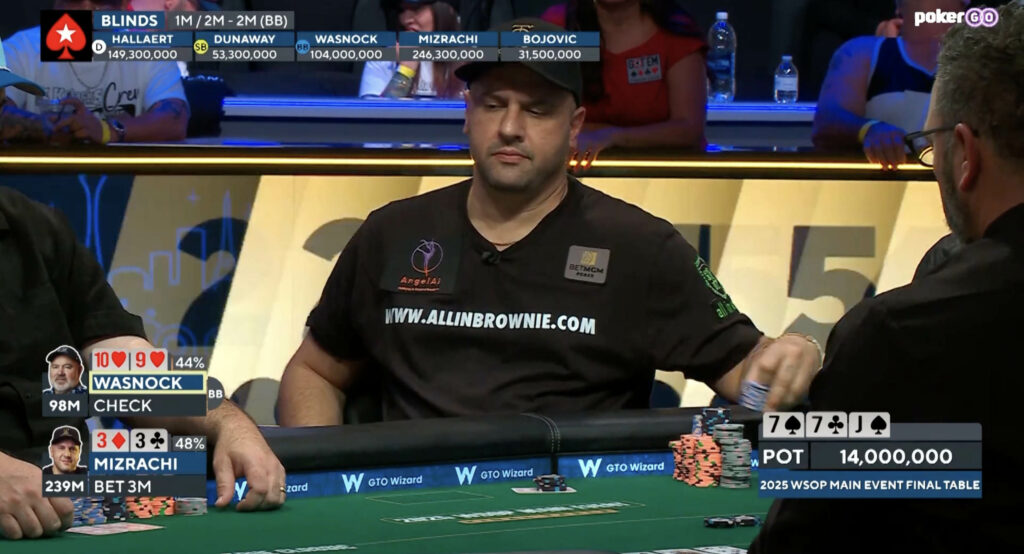
Street-by-Street Breakdown with Analysis
Preflop
Action: Mizrachi opens UTG to 4M with 3♦3♣. Wasnock defends BB with 10♥9♥. Pot: 11M.
Analysis: 33 open is standard at depth; BB defend with T9s is mandatory.
Flop 7♠7♣J♠
Action: Wasnock check (BB), Mizrachi 3M; call. Pot: 17M.
Analysis: Small c-bet (27%) targets high-card folds and protects vs. overcards. BB’s call with two overs/backdoors is routine.
Turn A♣
Action: Check, check.
Analysis: The ace smashes BB’s flatting range more than UTG’s narrow small c-bet range; once called, 33 shifts to showdown mode. Good check.
River A♥
Action: Wasnock (BB) bets 9M; Mizrachi folds. Wasnock wins.
Analysis: River polarises to Ax/7x and bluffs. 33 unblocks heart floats/bluffs but blocks nothing relevant for calls and has dreadful equity vs. value. Fold is correct, especially with ICM.
Strategic Verdict: On paired boards that pair again high, under-pairs become bluff-catchers at best; facing a polarised river stab, fold often and preserve stack.ICM rewards folding the thin spots. Without strong blockers or a compelling read, just let the under-pair go on the double-paired, ace-high runout.
Dara O’Kearney: ICM tends to slightly tighten calling ranges on the river, and Mizrachi’s fold is a textbook example of prioritising payout preservation over hero-calling in polarised situations.
Hand Overview / HAND 16 / Multiway Turn Lead & ICM Pressure
Stage: 2025 WSOP Final Table – 5/9,735
Players: Mizrachi (BB) 239.3M (~119.5 BB), Hallaert (CO) 149.3M (~74.5 BB), Dunaway (BTN) 52.3M (~26.2 BB)
Blinds: 1M / 2M with 2M ante
Effective Stack: ~26 BB
Pot Preflop: 18M
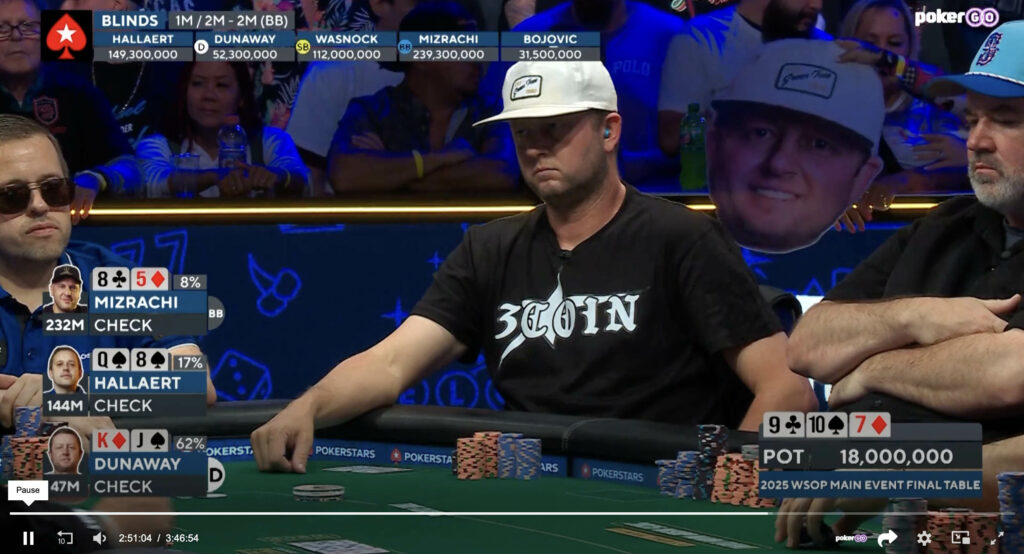
Street-by-Street Breakdown with Analysis
Preflop
Action: Hallaert opens CO 5M with Q♠8♠; Dunaway calls BTN with K♦J♠; Mizrachi completes BB with 8♣5♦.
Analysis: Hallaert (CO) open is fine 5-handed. Dunaway (BTN) call with KJ is standard in position. BB’s defend closing the action is loose but priced – 3M to win 18M – and plays well on dynamic boards vs. two wide ranges.
Flop 9♣10♠7♦
Action: Check, check, check.
Analysis: Excellent texture for BB: Mizrachi holds a double-gutter (6 or J makes a straight). Multiway, checking is reasonable; PFR checking range here is also common, keeping ranges capped and inviting delayed stabs.
Turn 2♠
Action: Mizrachi 10M; Hallaert calls; Dunaway calls. Pot: 48M.
Analysis: Strong, credible delayed lead (~56% pot). It punishes flop checks on a highly connected texture and targets folds from ace-high/under-pairs while charging draws. Hallaert picks up flush draw + gutter with Q♠8♠ – clear call. Dunaway continues with OESD (KJ on 9-T needs 8 or Q) and position.
River 2♥
Action: Mizrachi 25.5M; fold, fold.
Analysis: Beautiful river barrel (~53% pot). The paired deuce bricks straights/flushes and reduces thin hero-calls; both opponents are capped after passive lines. As chip leader, Mizrachi leverages ICM – mid-stacks hate bluff-catching with one pair here.
Strategic Verdict: Multiway, take the betting lead on turn when ranges are capped and you have equity or credible nutted hands; on brick rivers, ICM + capped ranges equals profitable follow-through.
Two medium stacks behind you make hero-calling expensive. This is a textbook chip-EV to ICM transfer – apply pressure where they’re least able to fight back.
Dara O’Kearney: I tend to play 2nd last tables aggressively because getting to the final table with a stack is huge… It’s massive in future equity terms, and this idea extends to final table play where Mizrachi, as chip leader, exploits capped ranges to build further without excessive risk.

Hand Overview / HAND 17 / SB vs Short Stack: Maximum Preflop Pressure
Stage: 2025 WSOP Final Table – 5/9,735
Players: Mizrachi (SB) 270.3M (~135 BB), Bojovic (BB) 31.5M (~15.8 BB)
Blinds: 1M / 2M with 2M ante
Effective Stack: ~15.8 BB
Pot Result: 33.5M to Mizrachi preflop
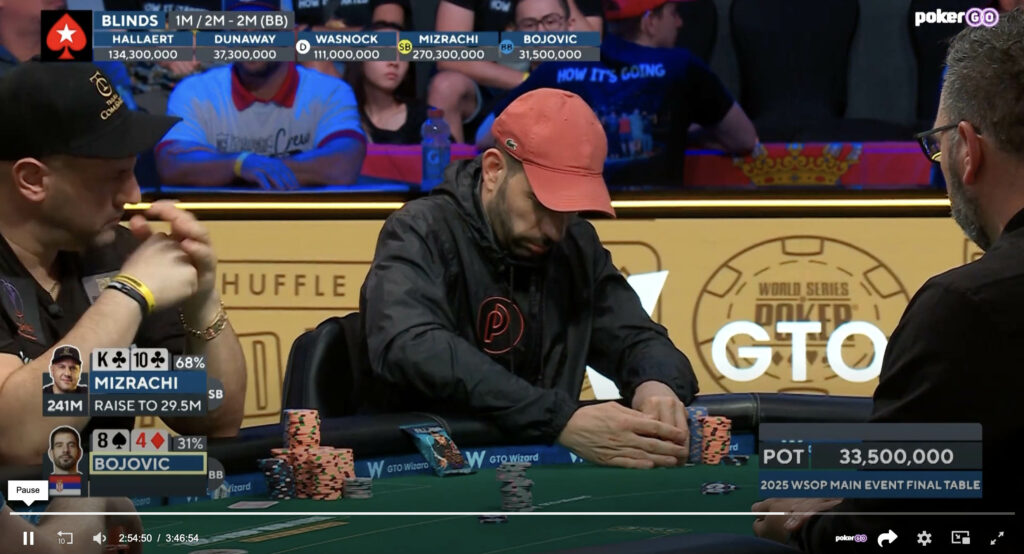
Street-by-Street Breakdown with Analysis
Preflop
Action: Mizrachi raises to 29.5M in SB with K♣10♣; Bojovic folds BB 8♠4♦.
Analysis: The non-all-in jam sizing effectively puts the 16-BB stack to the test. With ICM pressure high, BB must fold a huge portion of holdings; even many suited kings/queens get put in the blender. KTs gains from fold equity while avoiding the awkward min-raise/call-off thresholds that let BB shove profitably.
Strategic Verdict: Against short stacks under ICM, oversized SB opens function like jams – maximising folds and denying realisation from their profitable shove candidates. Exploitatively brilliant. Don’t give the 16-BB stack a clean re-shove; force them to commit their tournament or get out of the way.
Dara O’Kearney: Future equity is a thing in tournaments as well as ICM, and Mizrachi’s pseudo-jam here denies the short stack future playability while securing blinds and antes for his own stack advantage.
Hand Overview / HAND 18 / Four-Flush River Over-bet for Value
Stage: 2025 WSOP Final Table – 5/9,735
Players: Mizrachi (BTN) 274.3M (~137 BB), Hallaert (BB) 134.3M (~67 BB)
Blinds: 1M / 2M with 2M ante
Effective Stack: ~67 BB
Pot Preflop: 11M
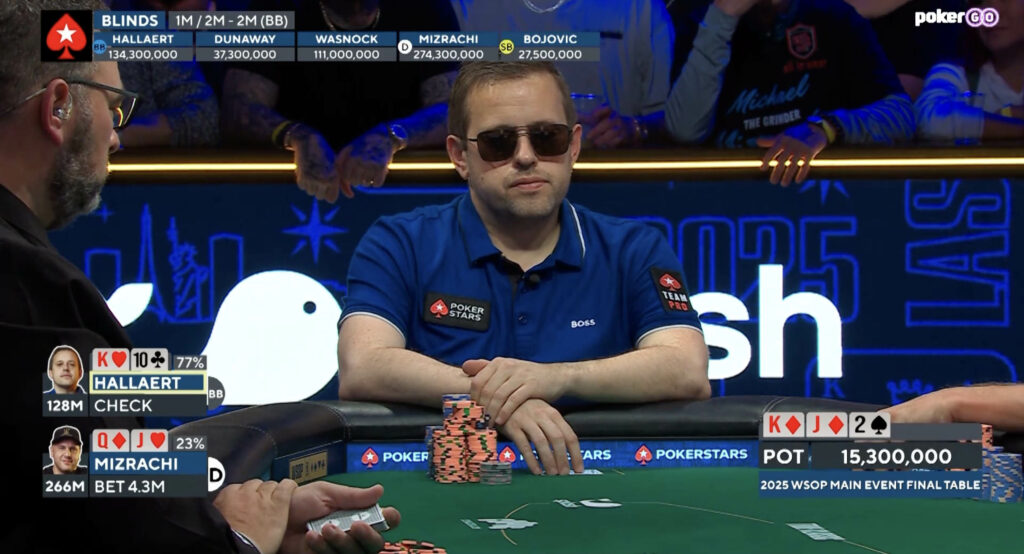
Street-by-Street Breakdown with Analysis
Preflop
Action: Mizrachi opens BTN 4M with Q♦J♥; Hallaert defends BB with K♥10♣.
Analysis: Standard open/defend.
Flop K♦J♦2♠
Action: Check (BB), Mizrachi 4.3M; call. Pot: 19.6M.
Analysis: Mizrachi (BTN) has second pair + backdoor diamonds; small-medium c-bet targets folds from weak pairs/air and sets up profitable turns. Hallaert (BB) calls with top pair, no diamond – mandatory.
Turn 5♦
Action: Hallaert check, Mizrachi bet 12.6M; Hallaert call. Pot: 44.8M.
Analysis: Third diamond supercharges BTN’s equity (now flush draw + pair with Q♦. Bigger sizing (~64% pot) pressures Kx without a diamond and extracts from worse diamonds that peeled flop.
River 7♦
Action: Hallaert check, Mizrachi over-bets 50M; Hallaert folds.
Analysis: The four-flush shifts nut advantage to BTN: as the preflop raiser with more diamond combos, Mizrachi credibly represents many strong flushes. Holding Q♦ is huge – blocks strong calls and upgrades his own hand to a K-high flush. The over-bet polarises and crushes Kx/no-diamond bluff-catchers.
Strategic Verdict: On four-flush rivers where you own the nut-density edge, blocker-backed over-bets extract maximum value and fold out dominated one-pair hands constrained by ICM. Perfect understanding of nut advantage. With Q♦ in hand, the over-bet is a slam dunk – you block their best calls and they can’t profitably hero without a diamond.
Dara O’Kearney: When it comes to aggressive lines, the high variance line should still be a profitable one, which supports Mizrachi’s overbet as a high-EV play leveraging blockers and ICM to force folds from constrained opponents.
Hand Overview / HAND 19 / UTG Pressure Under ICM
Stage: 2025 WSOP Final Table – 5/9,735
Players: Mizrachi (UTG) 298.2M (~149 BB), Wasnock (BB) 116M (~58 BB)
Blinds: 1M / 2M with 2M ante
Effective Stack: ~58 BB
Pot (Uncontested): 9M
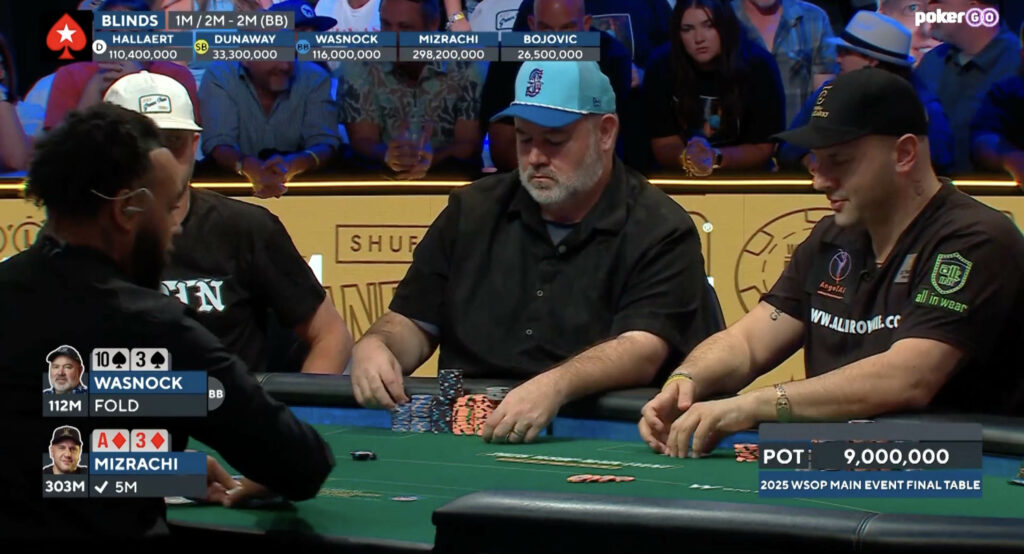
Street-by-Street Breakdown with Analysis
Preflop
Action: Mizrachi opens UTG to 5M with A♦3♦. Wasnock folds BB 10♠3♠.
Analysis: Five-handed, A3s is a fine UTG open – great playability, wheel equity, and robust blocker effects on 3-bets. The 2.5x sizing adds ICM pressure to the blinds and trims their defend frequency. BB’s fold is standard versus an UTG range that’s tight; dominated, poor realisation, and awkward reverse-implied odds.
Strategic Verdict: Suited wheel aces make profitable early-position opens 5-handed, especially with a slightly larger size that squeezes the blinds’ continues under ICM.Bigger UTG opens at a FT are underused. You buy folds from marginal blind defends and protect yourself from getting peeled too wide.
Dara O’Kearney: You’ll sometimes hear brave (or foolhardy) souls declare ‘f*ck ICM, I play for the win’, and they’ll achieve both of these stated objectives in the sense that they’ll make less money in the long run, but win more tournaments. However, here Mizrachi balances aggression with ICM-aware sizing to maximise $EV without sacrificing win potential.
Hand Overview / HAND 20 / SB vs. Short Stack: Leveraged Open
Stage: 2025 WSOP Final Table – 5/9,735
Players: Mizrachi (SB) 299.2M (~150 BB), Bojovic (BB) 26.5M (~13 BB)
Blinds: 1M / 2M with 2M ante
Effective Stack: ~13 BB
Pot (Uncontested): 28.5M
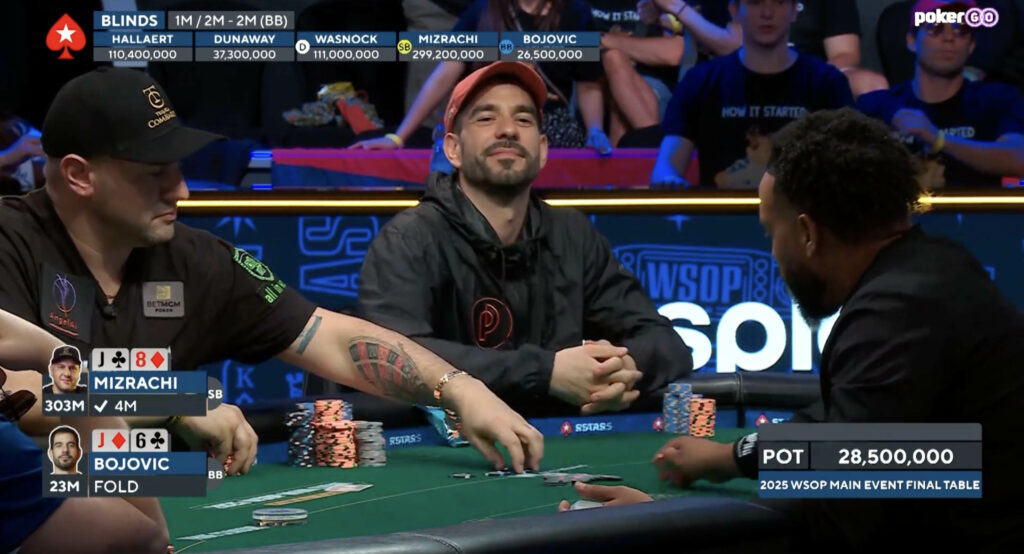
Street-by-Street Breakdown with Analysis
Preflop
Action: From the SB, Mizrachi raises to 24.5M with J♣8♦; Bojovic folds BB (J♦6♣).
Analysis: The oversized SB open functions like a near-jam, putting the 13-BB stack to a tournament decision. This denies the BB a profitable re-shove with many middling hands that would happily shove over a small open. J8o isn’t a standard value raise – it’s a pressure tool that captures the blinds/ante and exploits ICM. BB’s fold is correct: dominated when called and too thin to risk the lot.
Strategic Verdict: Against short stacks under ICM, large SB opens (pseudo-jams) maximise fold equity and deny realisation – a powerful exploit with hands that don’t want to face a shove. Don’t give the short stack a clean re-shove spot. Leverage sizing makes them fold a ton and protects your weaker SB holdings.
Dara O’Kearney: Gambling when 11 players remain is a costly ICM punt… But taking a high variance line with 18 players remaining is not that costly from an ICM perspective. The same is true here for final table pseudo-jams that exploit short stacks without high personal risk.

Hand Overview / HAND 21 / BB 3-Bet Punish vs. Button Steal
Stage: 2025 WSOP Final Table – 5/9,735
Players: Mizrachi (BTN) 303.2M (~151.6 BB), Hallaert (BB) 110.4M (~55.2 BB)
Blinds: 1M / 2M with 2M ante
Effective Stack: ~55 BB
Pot (Uncontested): 25.5M
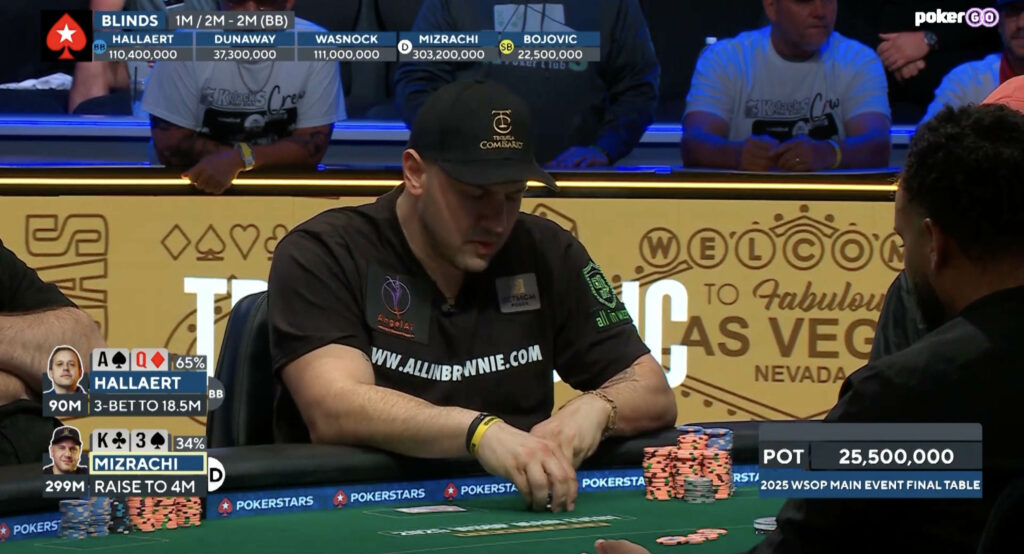
Street-by-Street Breakdown with Analysis
Preflop
Action: Mizrachi opens BTN to 4M with K♣3♠. Hallaert 3-bets BB to 18.5M with A♠Q♦. Mizrachi folds.
Analysis: Five-handed, a 2x-2.2x button open is standard; K3o is near the bottom but acceptable as a steal with position and a king blocker. From the BB, AQo is a premium linear 3-bet at ~55 BB effective, especially versus a wide BTN. The 4.6x sizing from out of position is excellent – it denies realisation, punishes the steal, and discourages flats. Folding K3o is mandatory: dominated when called, poor playability, and a weak 4-bet candidate compared with Axs/Kxsblockers. With ICM in play and Hallaert covering the remaining middling stacks, there’s no need for Mizrachi to wage a thin levelling war here.
Strategic Verdict: Against wide button opens, the big blind should use larger OOP 3-bet sizings with a strong linear range. Stealers must ditch the bottom of range to disciplined folds – especially under ICM and without robust blockers. Great example of ICM-aware resistance. AQo prints as a value 3-bet at this depth, and K3o is too flimsy to fight back. Preserve your chip lead for better spots.
Dara O’Kearney: Our intuition is much worse at recognising and quantifying how much additional compensation we pick up for folding, but Mizrachi’s fold exemplifies smart concession in a spot where continuing risks more than it gains under final table pressure.
Hand Overview / HAND 22 / Limped Pot, Capped Ranges & Thin Value
Stage: 2025 WSOP Final Table – 5/9,735
Players: Wasnock (SB) 107M (~53.5 BB), Mizrachi (BB) 299.2M (~149.6 BB)
Blinds: 1M / 2M with 2M ante
Effective Stack: ~53.5 BB
Pot Preflop: 6M
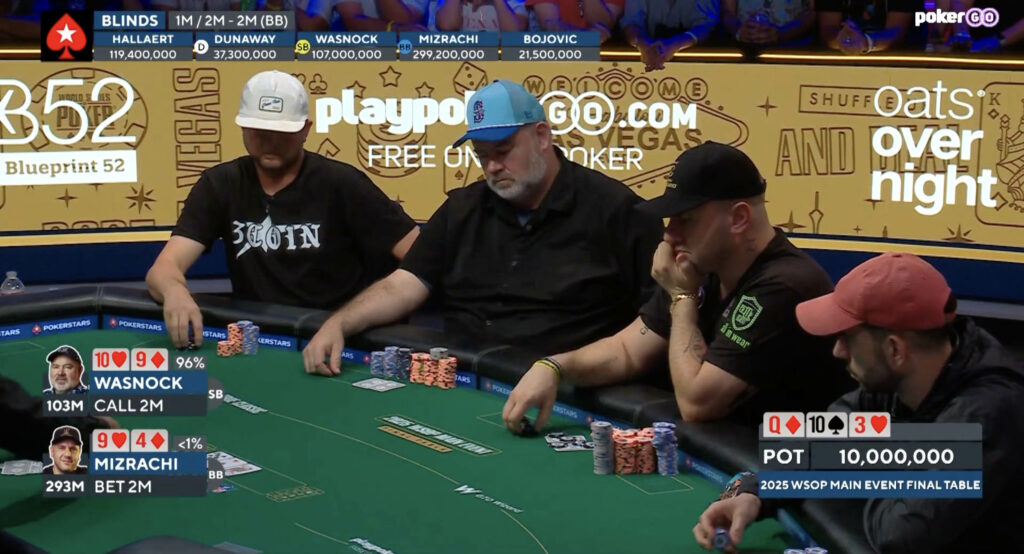
Street-by-Street Breakdown with Analysis
Preflop
Action: Wasnock limps SB with 10♥9♦. Mizrachi checks BB with 9♥4♦.
Analysis: Standard limp from Wasnock (SB) at depth; T9o has good playability. BB check is fine – dominated often, okay realisation with position post flop reversed (SB acts first).
Flop Q♦10♠3♥
Action: Wasnock checks; Mizrachi 2M; Wasnock calls. Pot 10M.
Analysis: Mizrachi (BB’s) small stab (~33%) is a textbook “range poke” into a capped limp range. With 9-4 offsuit, he targets auto-folds (A-x air, low whiffs). Wasnock (SB’s) call with middle pair is routine and keeps BB honest.
Turn 7♦
Action: Check, check.
Analysis: Turn connects some SB completes (T7, 87, diamonds). BB’s equity/story hasn’t improved; checking back prevents value-cutting and retains bluff options on some rivers.
River 3♠
Action: Wasnock bet 3M; Mizrachi folds.
Analysis: Paired low card reduces BB’s incentive to bluff-catch thin. SB’s small blocker/value bet targets exactly ace-high floats and pocket 4-6 type hands that stabbed once and gave up. Fold with 9-4 is disciplined.
Strategic Verdict: In limped SB vs BB pots, small flop stabs print versus capped check ranges – but when your equity doesn’t improve and the board unlocks SB value, downshift to showdown discipline. The river blocker bet is classic. You price out bluffs and extract thinly without bloating the pot – and from the BB, folding the bottom of your range is just good ICM hygiene.
Dara O’Kearney: I approve of Mizrachi’s fold, as it avoids thin bluff-catching in a limped pot where ICM amplifies the cost of errors.
Hand Overview / HAND 23 / SB vs Short: Pseudo-Jam Pressure (Again)
Stage: 2025 WSOP Final Table – 5/9,735
Players: Mizrachi (SB) 293.2M (~146.6 BB), Bojovic (BB) 21.5M (~10.8 BB)
Blinds: 1M / 2M with 2M ante
Effective Stack: ~10.8 BB
Pot (Uncontested): 23.5M
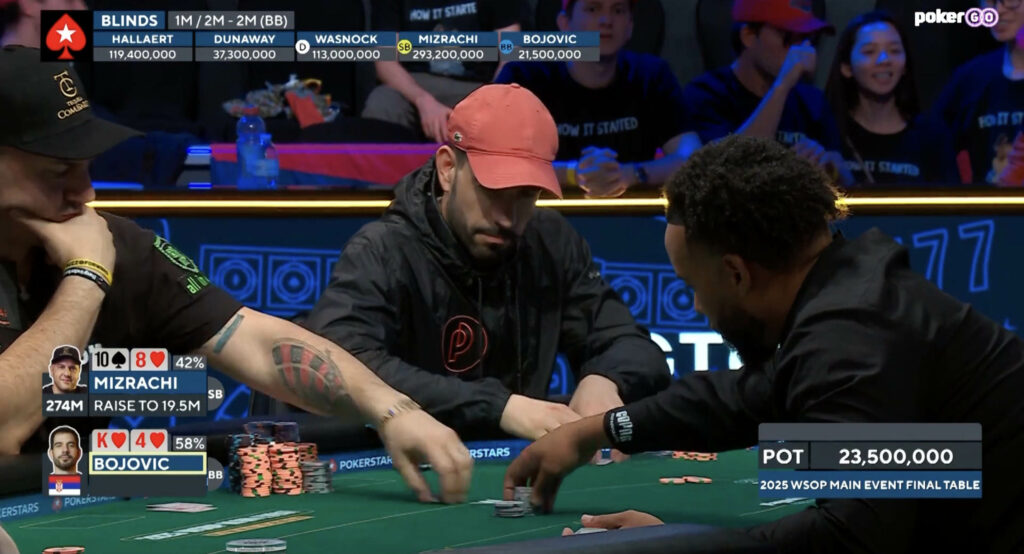
Street-by-Street Breakdown with Analysis
Preflop
Action: Mizrachi raises SB to 19.5M with 10♠8♥; Bojovic folds BB with K♥4♥.
Analysis: The oversized Mizrachi (SB) raise functions as a near-jam versus ~11 BB – a nasty ICM spot for the short stack. T8o is not thrilled to face a shove; leveraging size prevents it, harvesting blinds/ante at massive frequency. BB’s fold is correct: poor equity realisation and dominated calls.
Strategic Verdict: Against ~8-12 BB stacks, large SB opens maximise fold equity and deny their best re-shove candidates the chance to realise – perfect for middling offsuit hands. Exploit the ICM choke point. Don’t offer the short stack a clean shove; force them to risk it all or surrender.
Dara O’Kearney: As before, this exemplifies extending using aggression as chip leader for short-stack exploitation for chip accumulation.
Hand Overview / HAND 24 / 3-Bet Pressure & Double-Paired Board Domination
Stage: 2025 WSOP Final Table – 5/9,735
Players: Wasnock (CO) 113M (~56.5 BB), Mizrachi (BTN) 297.2M (~148.6 BB)
Blinds: 1M / 2M with 2M ante
Effective Stack: ~56.5 BB
Pot After Flop: 50M
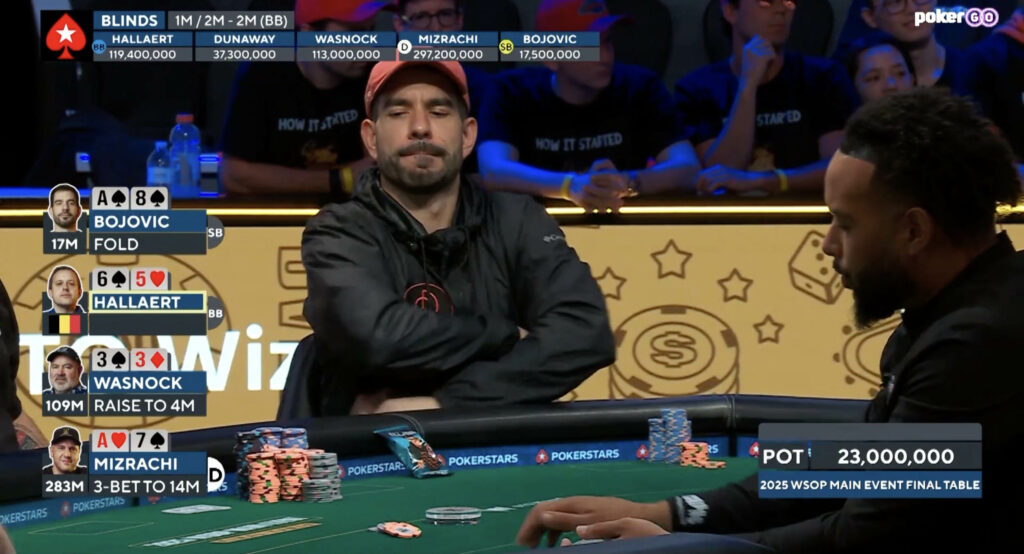
Street-by-Street Breakdown with Analysis
Preflop
Action: Wasnock opens CO to 4M with 3♠3♦. Mizrachi 3-bets BTN to 14M with A♥7♠. Wasnock calls. Pot 33M.
Analysis: Wasnock (CO) open is fine. BTN 3-bet with A7o leverages ace blocker + position and FT ICM – a light but profitable pressure candidate versus CO. Flat by 33 set-mines but risks post flop pain on high-card boards.
Flop 4♥4♦5♣
Action: Wasnock check; Mizrachi 8.5M; call. Pot 50M.
Analysis: On paired, low boards the 3-bettor owns range advantage (overpairs, better high cards). Small c-bet (~26%) denies equity from 66-88/Ax floats and keeps the initiative. 33 can’t fold yet with backdoors and pot odds.
Turn 5♠
Action: Wasnock check; Mizrachi 20M; Wasnock folds.
Analysis: The board double-pairs, crushing the caller’s under-pairs and favouring the 3-bettor’s high-card range. The 40% pot second barrel credibly represents overpairs and trips; 33 becomes a poor bluff-catcher with almost no clean rivers. Excellent pressure card to push folds.
Strategy Verdict: Double-paired, low boards amplify the 3-bettor’s range advantage. Ace-high, blocker-heavy barrels generate folds from small pairs that can’t realise.This is where ICM meets board coverage. Your high-card advantage gets magnified; keep betting and make the small pairs face reality.
Dara O’Kearney: Double paired boards tighten calling ranges further, as ICM pulls both ranges tighter, making Mizrachi’s continued aggression a high-EV exploit against capped defences.
Hand Overview / HAND 25 / Value Line vs Draw-Heavy Calling Range
Stage: 2025 WSOP Final Table – 5/9,735
Players: Mizrachi (CO) 324.7M (~162.4 BB), Hallaert (SB) 115.4M (~57.7 BB), Dunaway (BB) 37.3M (~18.7 BB)
Blinds: 1M / 2M with 2M ante
Effective Stack: ~57.7 BB (postflop HU vs SB)
Pot Preflop: 14M
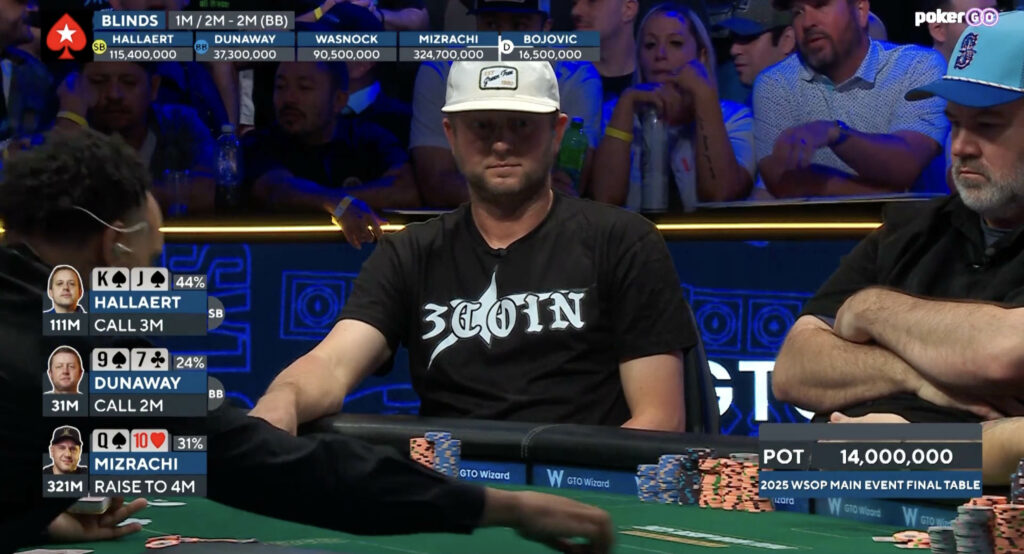
Street-by-Street Breakdown with Analysis
Preflop
Action: Mizrachi opens CO to 4M with Q♠10♥; Hallaert calls SB with K♠J♠; Dunaway calls BB with 9♠7♣.
Analysis: Standard open/calls. SB’s KJs flops well; BB defend is fine with price.
Flop K♦7♣3♥
Action: Hallaert check (SB), Dunaway check (BB); Mizrachi bet 5.5M; SB calls; BB folds. Pot 25M.
Analysis: Multiway c-bet with second pair is good – protection vs. overcards and denies equity to gutters/backdoors. SB’s call with top pair + backdoors keeps lots of dominated hands in and conceals strength.
Turn Q♣
Action: Hallaert check; Mizrachi 21.5M; Hallaert (SB) calls. Pot 68M.
Analysis: Turn upgrades CO to top two; large bet (~86%) targets Kx, QJ, J9, KJ, and strong draws. SB’s KJ picks up an open-ender (A or 9 completes), so calling is standard – many worse hands exist and redraws are live.
River 4♠
Action: Hallaert check; Mizrachi 60M; Hallaert (SB) calls. Pot 188M. Mizrachi wins.
Analysis: Bricked river preserves top two’s nutted status versus SB’s range, which is heavy in one-pair + missed draws. The near-pot value bet is excellent: it extracts maximum from KQ/KJ/QT and punishes sticky bluff-catchers constrained by ICM. SB’s call isn’t crazy – beats busted draws and under bluffed spots – but versus CO’s value-heavy line, it’s thin.
Strategic Verdict: When your hand climbs the value ladder on the turn and the river bricks, big polar value bets punish capped, draw-heavy defend ranges – especially against ICM-constrained opponents. Top two on a missed-draw river is a green light. In FT dynamics, players under-bluff these spots – so lean into big value and make the Kx hands pay.
Dara O’Kearney: When ICM influences risk assessment in multi-way pots, Mizrachi’s large river bet exploits the capped nature of defends while Hallaert’s thin call risks ICM punishment.
Hand Overview / HAND 26 / SB 3-Bet Leverage vs. Button Open
Stage: 2025 WSOP Final Table – 4/9,735
Players: Wasnock (BTN) 106M (~53 BB), Mizrachi (SB) 423.7M (~212 BB)
Blinds: 1M / 2M with 2M ante
Effective Stack: ~53 BB
Pot (Uncontested): Preflop
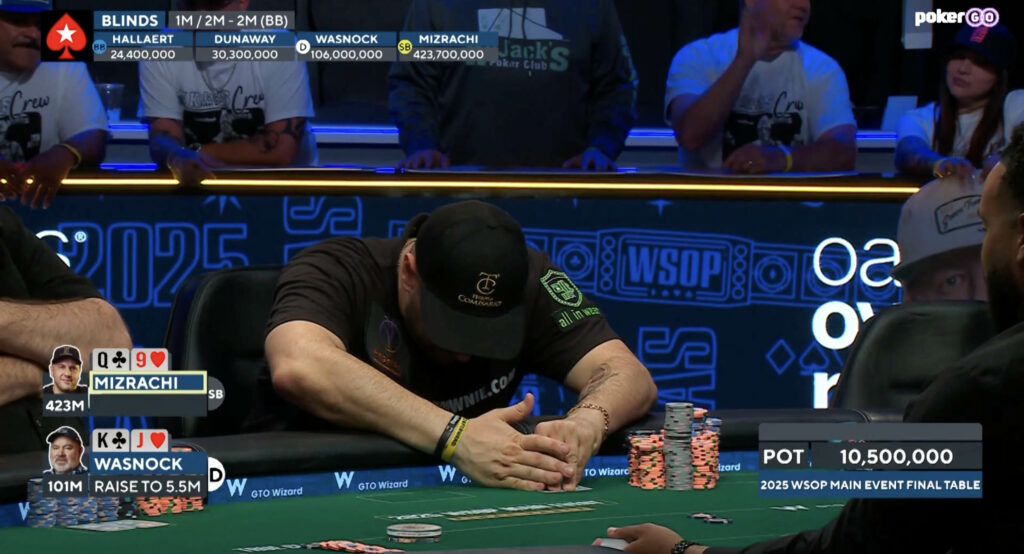
Street-by-Street Breakdown with Analysis
Preflop
Action: Wasnock opens BTN to 5.5M with K♣J♥. Mizrachi 3-bets SB to 16M with Q♣9♥; BB folds, BTN folds.
Analysis: Button’s open is standard 4-handed. From SB, the 3-bet to ~3x applies maximum pressure to a medium stack under ICM. Q9o isn’t a classic value hand, but as a light 3-bet bluff it works: it denies equity, realises position post (if called), and prevents BTN from comfortably realising with hands like KTo/QJo/Ax wheel. Excellent exploit with chip lead.
Strategic Verdict: As covering stack, SB should 3-bet liberally vs BTN, using blocker-ish or middling offsuit hands to tax wide opens and force folds under ICM. Leverage matters more than blockers here. The medium stack hates playing 3-bet pots out of position to the chip leader – take the pot pre and move on.
Dara O’Kearney: With ICM, as everyone has to play tighter, this is a spot where you can pick up a lot of chips, so here Mizrachi as leader uses light 3-bets to punish.

Hand Overview / HAND 27 / Two Shorts in the Blinds: Pseudo-Jam Steal
Stage: 2025 WSOP Final Table – 4/9,735
Players: Mizrachi (BTN) 433.2M (~216.6 BB), Hallaert (SB) 20.4M (~10.2 BB), Dunaway (BB) 30.3M (~15.2 BB)
Blinds: 1M / 2M with 2M ante
Effective Stack: ~10 BB (vs SB)
Pot (Uncontested): Preflop
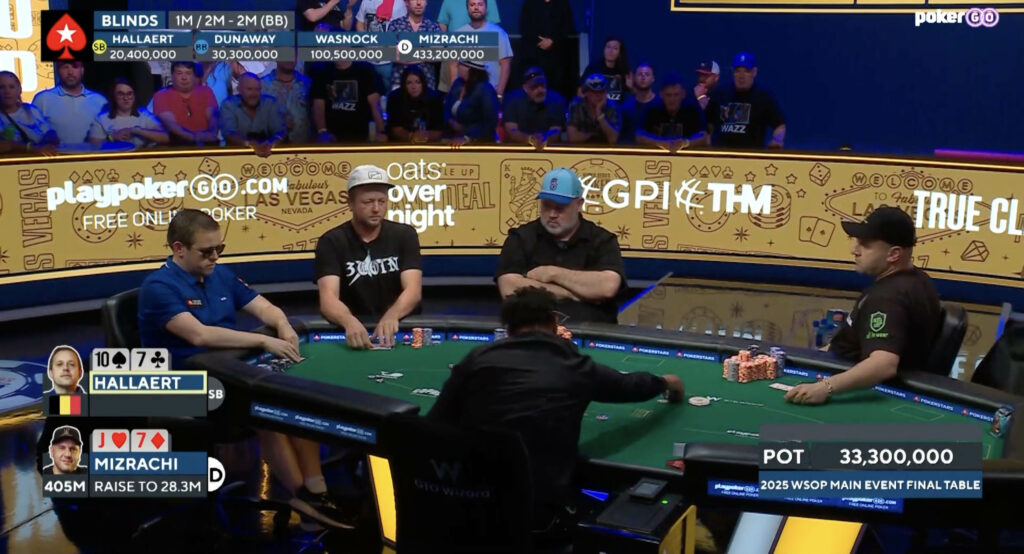
Street-by-Street Breakdown with Analysis
Preflop
Action: From the BTN, Mizrachi raises to 28.3M with J♥7♦. SB folds 10♠7♣, BB folds Q♣4♦.
Analysis: With two short stacks behind, the oversized raise functions as a near-jam that denies them clean re-shove opportunities. Perfect exploit: J7o isn’t thrilled to call off vs shoves; the size makes them fold a ton and prints the antes/blinds at massive frequency.
Strategic Verdict: When both blinds are short, use large steal sizings to weaponise ICM – they can’t defend widely or re-shove light. Textbook pressure. Don’t give 10 -15 BB stacks a profitable shove; price them out and harvest chips risk-free.
Dara O’Kearney: When you take a high variance line early as Mizrachi did, this puts you in a position to build a stack while most of the table will tighten up. His pseudo-jam continues to harvest value from ICM constrained blinds.
Hand Overview / HAND 28 / Low, Connected Board: Small C-Bet Print
Stage: 2025 WSOP Final Table – 4/9,735
Players: Mizrachi (UTG) 438.2M (~219 BB), Wasnock (BB) 100.5M (~50 BB)
Blinds: 1M / 2M with 2M ante
Effective Stack: ~50 BB
Pot After Preflop: 11M
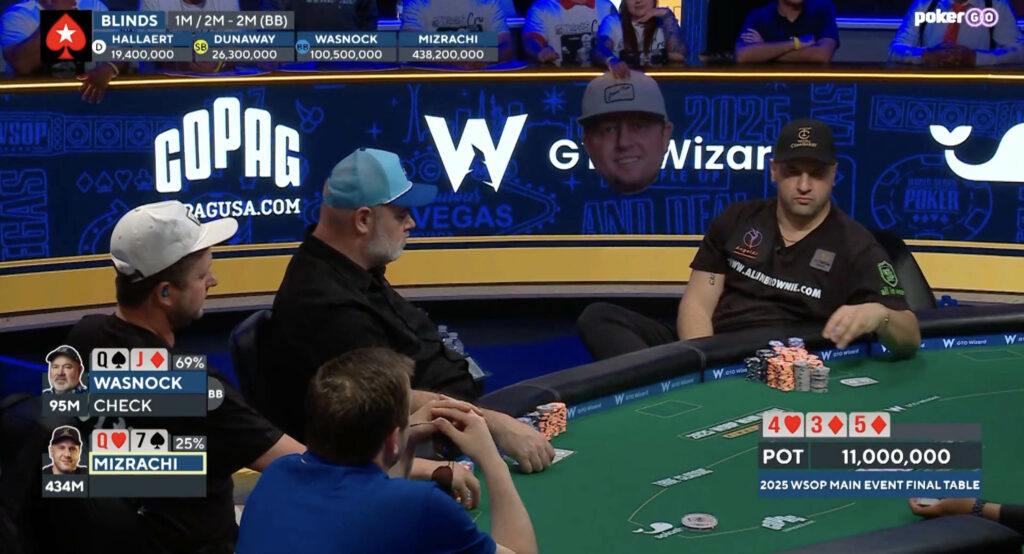
Street-by-Street Breakdown with Analysis
Preflop
Action: Mizrachi opens UTG to 4M with Q♥7♠. Wasnock defends BB with Q♠J♦. Pot: 11M.
Analysis: Four-handed, Q7o open from UTG is loose but defendable at very deep stacks with table control. BB defend with QJo is standard.
Flop 4♥3♦5♦
Action: Wasnock (BB) check (BB), Mizrachi 5.1M; BB folds.
Analysis: Though the texture connects well with BB (A5/A4/65, small pairs), the small c-bet (~46%) works because UTG holds range advantage in overpairs/strong Ax and Q7 has backdoor hearts + gutshot to a 6. QJ without a diamond faces poor playability OOP and correctly folds.
Strategic Verdict: On low, connected flops, range + initiative + backdoors justify small c-bets – you fold out two overcards with bad realisation. Small bet, big EV. You don’t need the board – you need initiative, range, and pressure on their worst continues.
Dara O’Kearney: Postflop ICM heuristics suggest that ICM reduces bluffing frequencies on connected boards, making Mizrachi’s small c-bet a safe, high-frequency print against tightened defences.
Hand Overview / HAND 29 / Short-Stack Jam vs BB Call: Risk-Premium Reality
Stage: 2025 WSOP Final Table – 4/9,735
Players: Hallaert (BTN) 19M (~7.6 BB), Mizrachi (BB) 445.5M (~178 BB)
Blinds: 1M / 2.5M with 2.5M ante
Effective Stack: ~7.6 BB
Pot After All-In: 41.5M
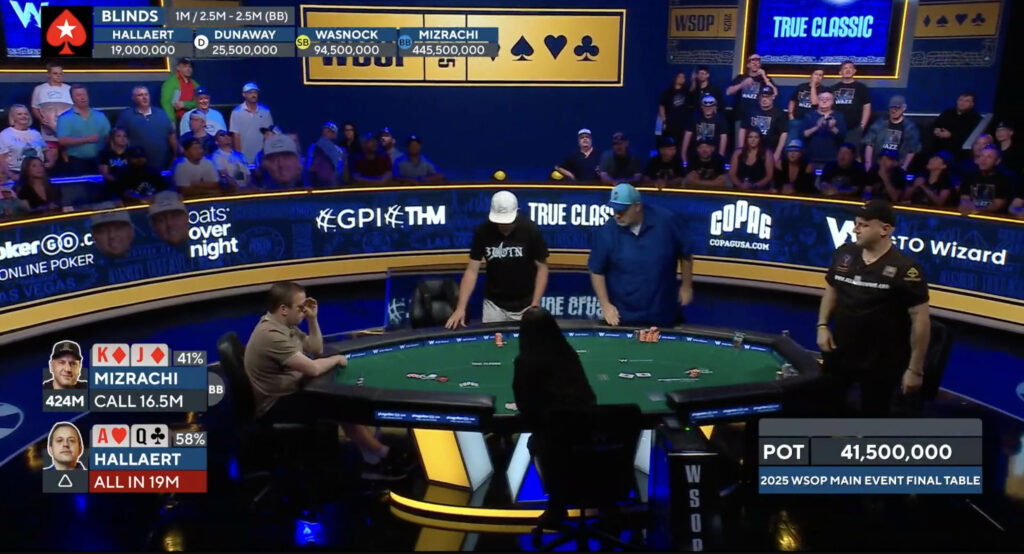
Street-by-Street Breakdown with Analysis
Preflop
Action: Hallaert shoves BTN with A♥Q♣. Mizrachi calls from BB with K♦J♦ (covers).
Analysis: BTN jam with AQo at ~7-8 BB is slam-dunk – dominates reshoves/calls and avoids post flop. BB’s call with KJ suited is a profitable, range-driven defend vs BTN shove; suited broadways with good equity and blockers perform well even under ICM when you cover.
Board runs out: 5♠4♠10♠J♣9♠
Result: Turn J pairs Mizrachi; he holds vs AQ high. Hallaert eliminated.
Strategic Verdict: Versus BTN jams at ~8 BB, BB should call wider when covering – suited broadways are solid equity + play well against the shover’s range. Correct shove, correct call. With the pay jumps, covering stack has the luxury to realise equity – KJ suited is well within calling thresholds.
Dara O’Kearney: Risk premiums tighten short-stack shoves but allow covering stacks like Mizrachi’s to call wide profitably.
Hand Overview / HAND 30 / SB Near-Jam vs ~10 BB & Call-Off
Stage: 2025 WSOP Final Table – 3/9,735
Players: Mizrachi (SB) 465.5M (deep), Dunaway (BB) 25.5M (~10.2 BB)
Blinds: 1M / 2.5M with 2.5M ante
Effective Stack: ~10 BB
Pot After All-In: 48.5M
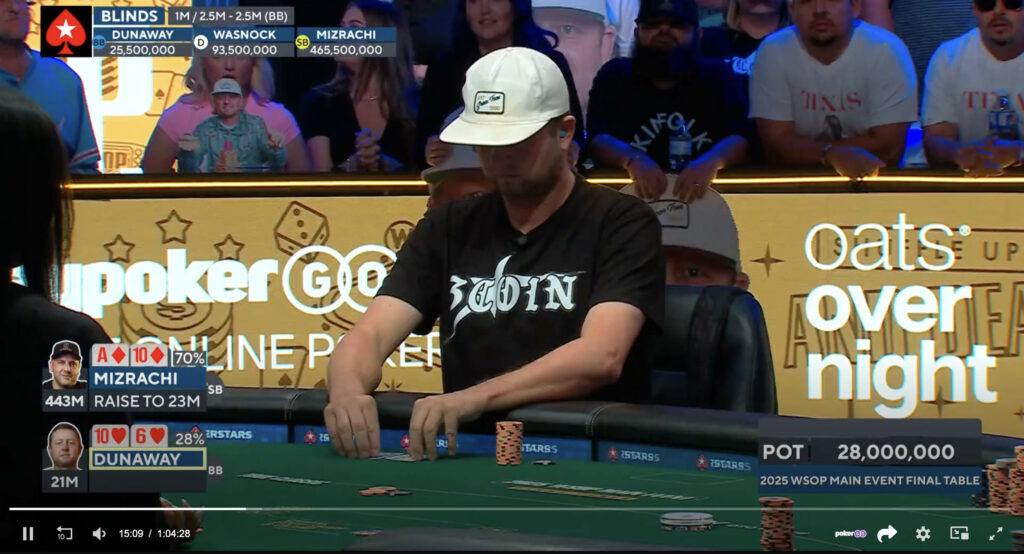
Street-by-Street Breakdown with Analysis
Preflop
Action: Mizrachi raises SB to 23M with A♦10♦. Dunaway calls from BB with 10♥6♥ and is all in.
Analysis: SB’s near-jam open puts the 10-BB stack to a decision — excellent with a strong hand like ATs, which is happy to get it in anyway. BB’s call-off with T6s is likely too loose: versus a chip-leader’s polarised large-raise range, you’ll be dominated often and need ~42% equity given the price – T6s is typically below that.
Board runs out: K♣4♦Q♦4♠3♦
Result: Diamonds roll out; Mizrachi wins. Dunaway eliminated.
Strategic Verdict: Against large SB opens with ~10 BB, defend ranges must tighten considerably; without strong playability or blockers, fold the dominated suited gapers. Great sizing from the SB – you deny the BB a clean re-shove and force sub-par call-offs. As the short stack, you need tighter standards versus that leverage.
Dara O’Kearney: Blinding out is a major leak heads up but here Dunaway’s call-off is too loose, while Mizrachi’s jam is clearly profitable.







